News
For Your Reference: Threading Letters
From embroidery to weaving, there is a long history incorporating letterforms into fabric. In this visit to the Archive’s stacks, we’re pulling multiple threads on items that tie text to textiles.
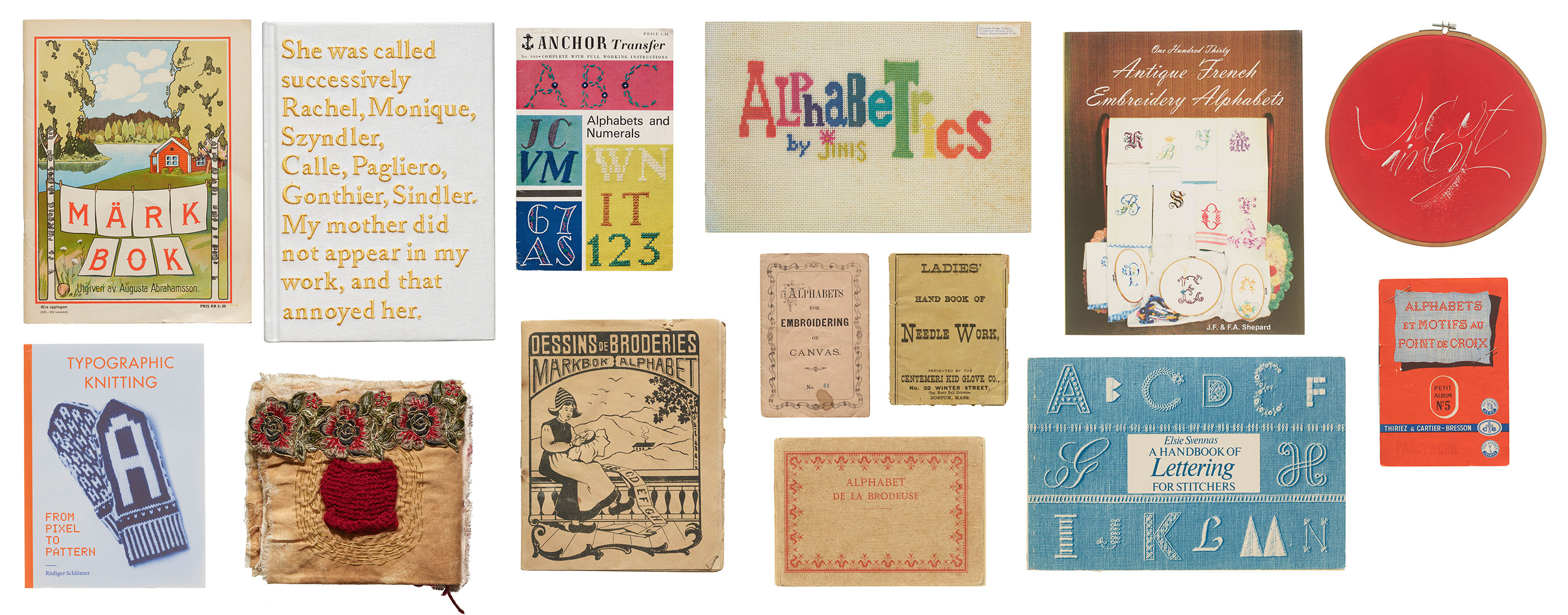
The word “text” originated from the Latin word “textus,” which means “a weaving” or “a fabric.” In ancient times, textus referred specifically to the process of weaving fabric. Over time, the meaning of the word expanded to include written or printed material, reflecting the idea of words being woven together to create a coherent written work. This metaphorical extension continues today with words and phrases such as seamless, threadbare, unraveled, looming, frayed, tangled, and spinning a yarn, highlighting the connection between the physical act of weaving fabric and the intellectual act of composing written language, both of which involve the interlacing of individual elements to create a unified whole. In this installment of For Your Reference, we revisit the Archive’s stacks for books and other items that build a tangible connection between threads and letterforms.
Embroidery, an art form dating back centuries, involves the embellishment of fabric or other materials using a needle to apply thread or yarn. With its origins deeply rooted in various cultures, embroidery boasts a diverse range of techniques and styles. From cross stitch to crewelwork and needlepoint, blackwork and whitework to Sashiko and Zari, the world of embroidery offers an array of techniques to explore. Practiced by both royalty and the general populace, the craft has used letterforms for their basic functionality (think laundry labels), as well as elevated to symbols of personal branding, decoration, and even fine art. In his 2018 Letterform Lecture, Type and Tectonics, Doug Clouse muses on the social context of needlework, and other tectonic crafts, that are often called “leisure” activities, despite the elaborate skill they exhibit.
While embroidery is primarily about embellishing existing fabric, weaving is a method of making new fabric from thread or yarn on a loom. Methods of weaving include knitting, crocheting, felting, and braiding or plaiting. For more connections between weaving and typography, see Vivian Sming’s article.
Throughout history, embroidery and weaving have evolved alongside changes in technology, fashion, and social norms. The Industrial Revolution brought advancements in textile production, making woven goods more accessible to a wider audience. Embroidery has served not only as a production technique but also as a means of cultural expression, storytelling, and social identity. The enduring appeal of these crafts lie in their versatility, beauty, and ability to connect us to the rich tapestry of human history. Today we also have digital resources that aid instruction and preservation, fortifying oral traditions and other physical archival resources. Below are a selection of reference books showcasing techniques and designs for embroidering and weaving letters, as well as some objects in the Archive that use embroidery to craft letters.
Alphabet de la Brodeuse: Lettres, Chiffres, Monogrammes et Ornements…
Bibliotheque DMC, Mulhouse, France, ca. 1900 (6th French ed.)
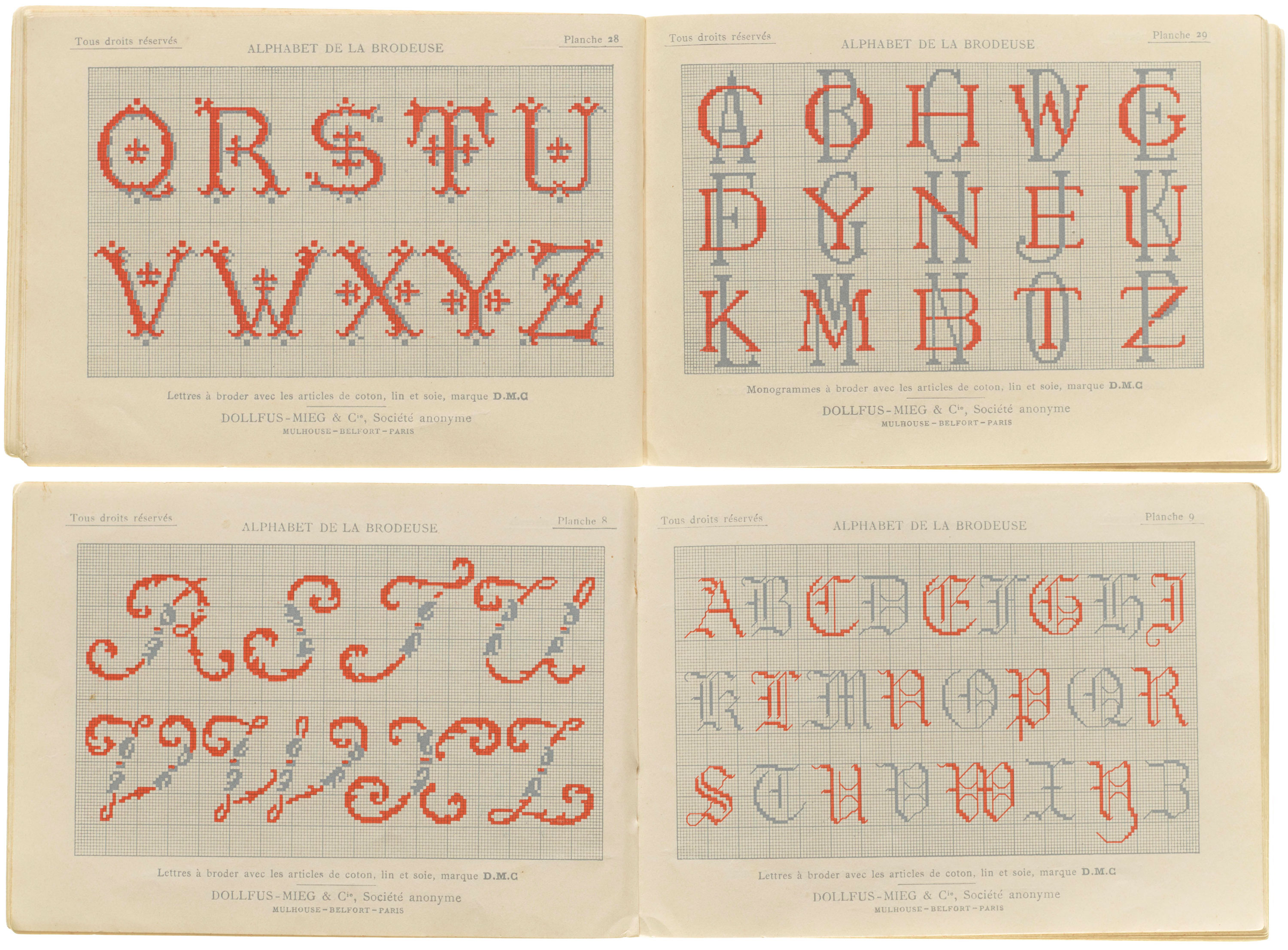
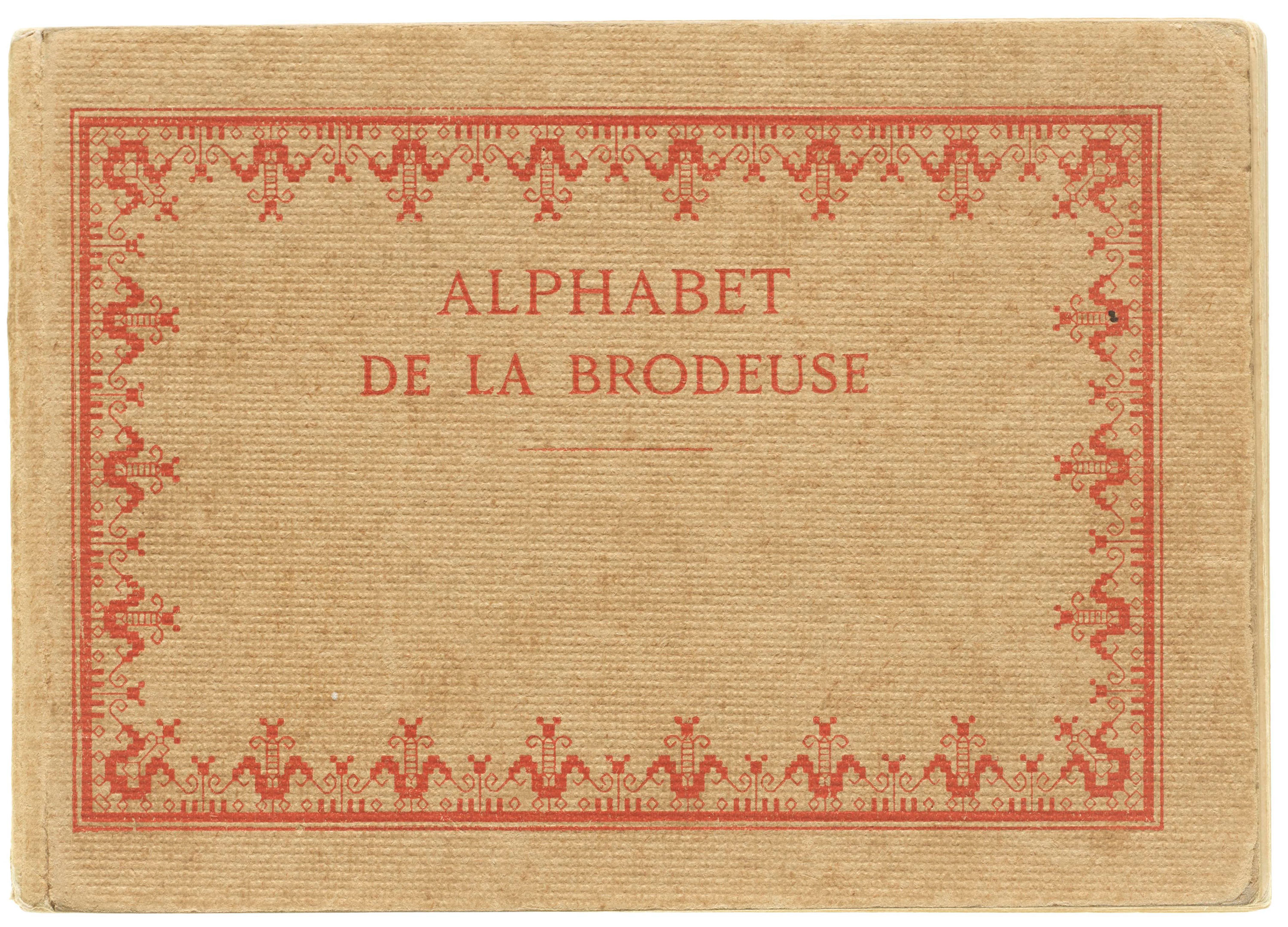
The Embroiders Alphabet: Letters, Numbers, Monograms and Ornaments for Counted Stitching followed by a series of models with overlays for white embroidery is a practical guide for embroiderers, providing a variety of motifs and models accompanied by tools to accurately reproduce them on different textile surfaces. The Archive’s copy is unfortunately missing the transparent overlay sheets, which facilitate the transfer of the motifs onto the fabric using an iron.
The Archive also holds a later (13th) edition of this title which was published in a slightly larger format.
Alphabetrics
Virginia Smith, Greenville, SC, 1974
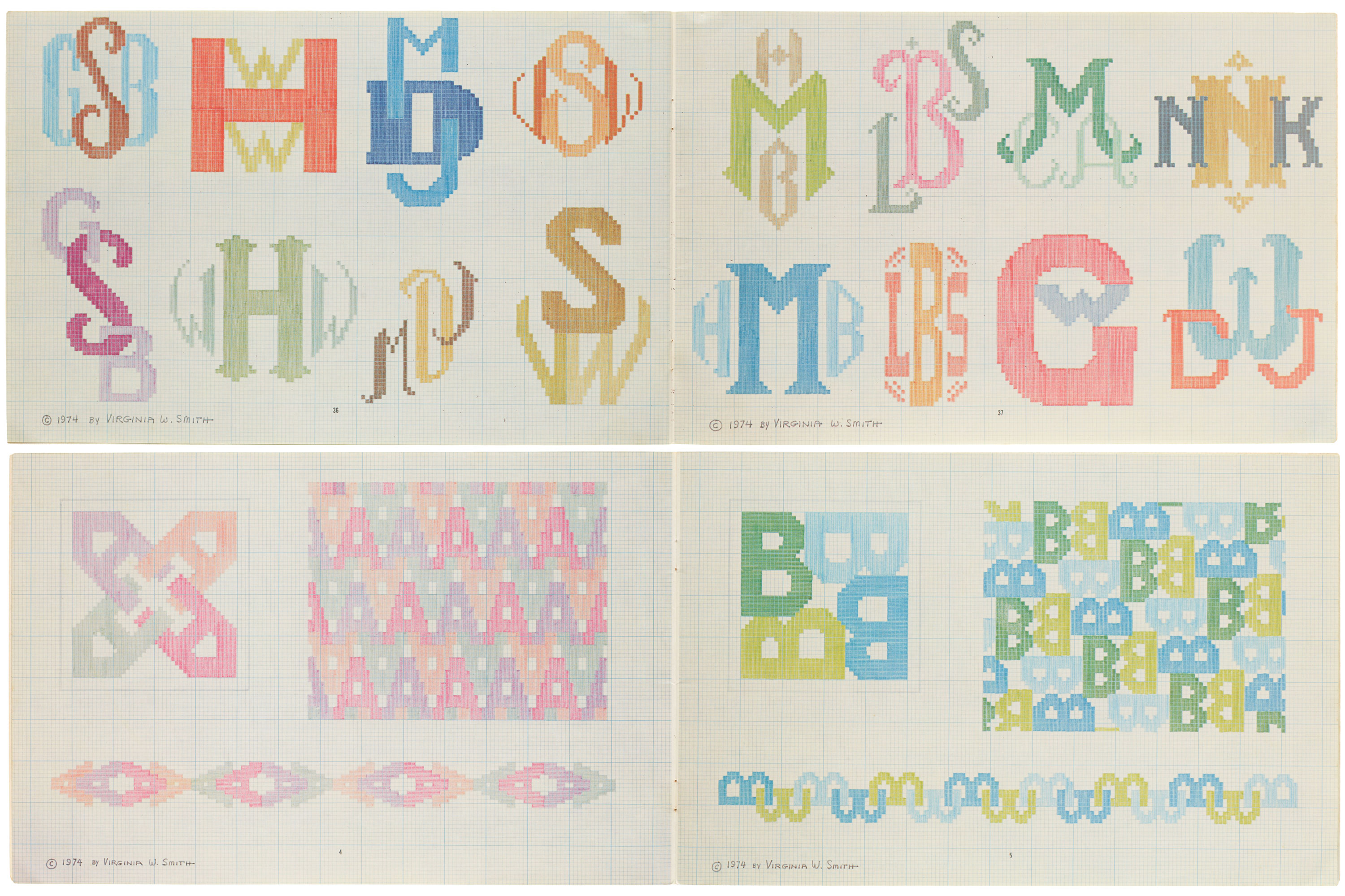
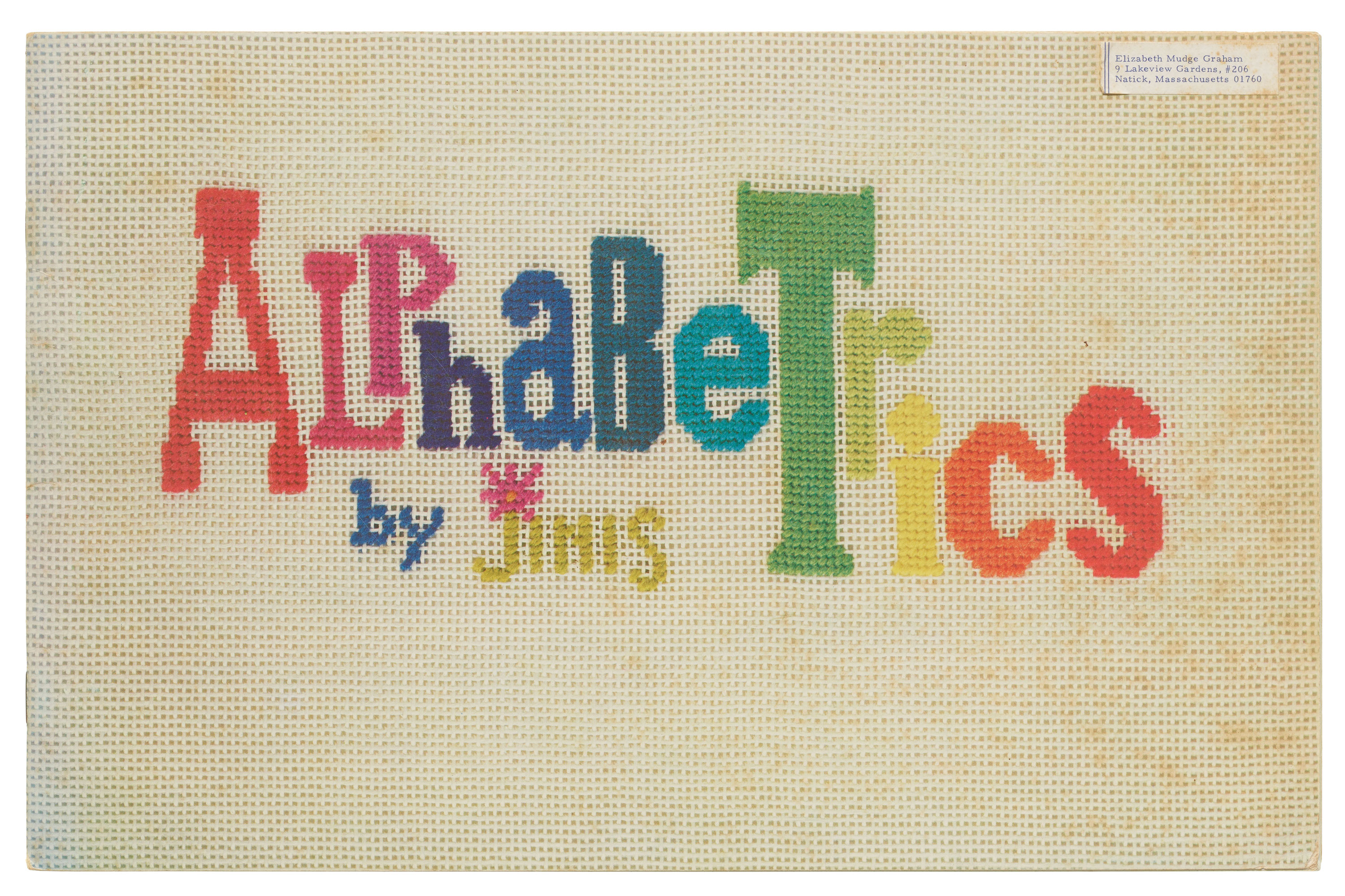
Written by Virginia (Jini) Smith, who also authored the related Alphagraphics, this book contains design charts for embroidering Latin letters and offers more than just alphabets and monogram suggestions. A grid is filled in (with what appears to be colored markers) to make it easy to count the stitches. It comprises six distinct sections, each presenting a unique set of designs. Every letter of the alphabet is creatively arranged into geometric patterns, suitable for use as a focal point, background, or border in needlepoint or cross stitch projects. The letter B serves as a pattern and monogram, with each letter receiving a similar design treatment throughout the book, ensuring a consistent and cohesive approach to stitching. Examples of monograms in a wide range of styles and sizes are provided to showcase the flexibility one has in adjusting letter shapes to achieve an interesting design.
Alphabets Et Motifs Au Point De Croix Petit, Album No. 5
Thiriez & Cartier-Bresson, Lille, France, ca. 1940
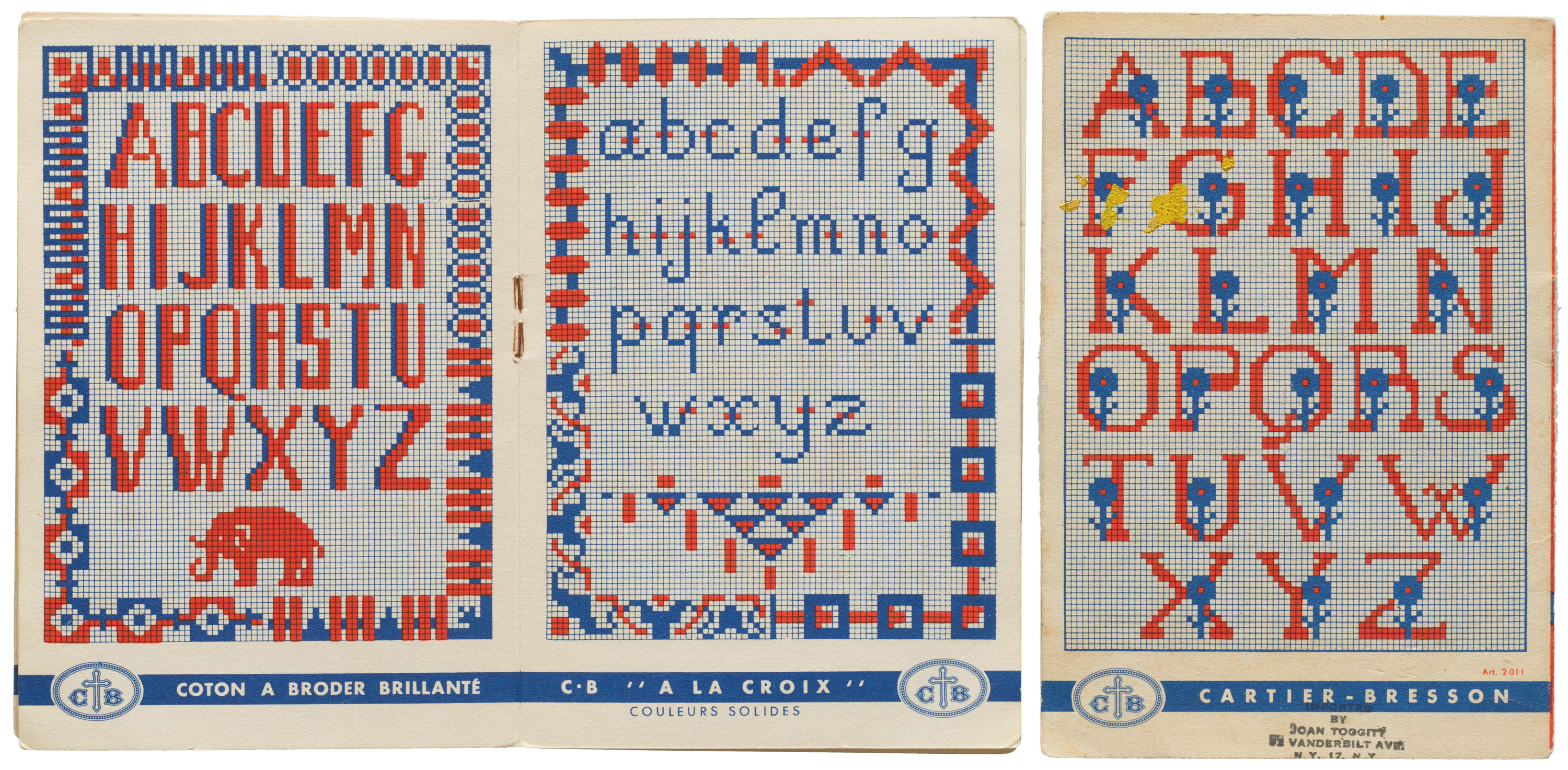
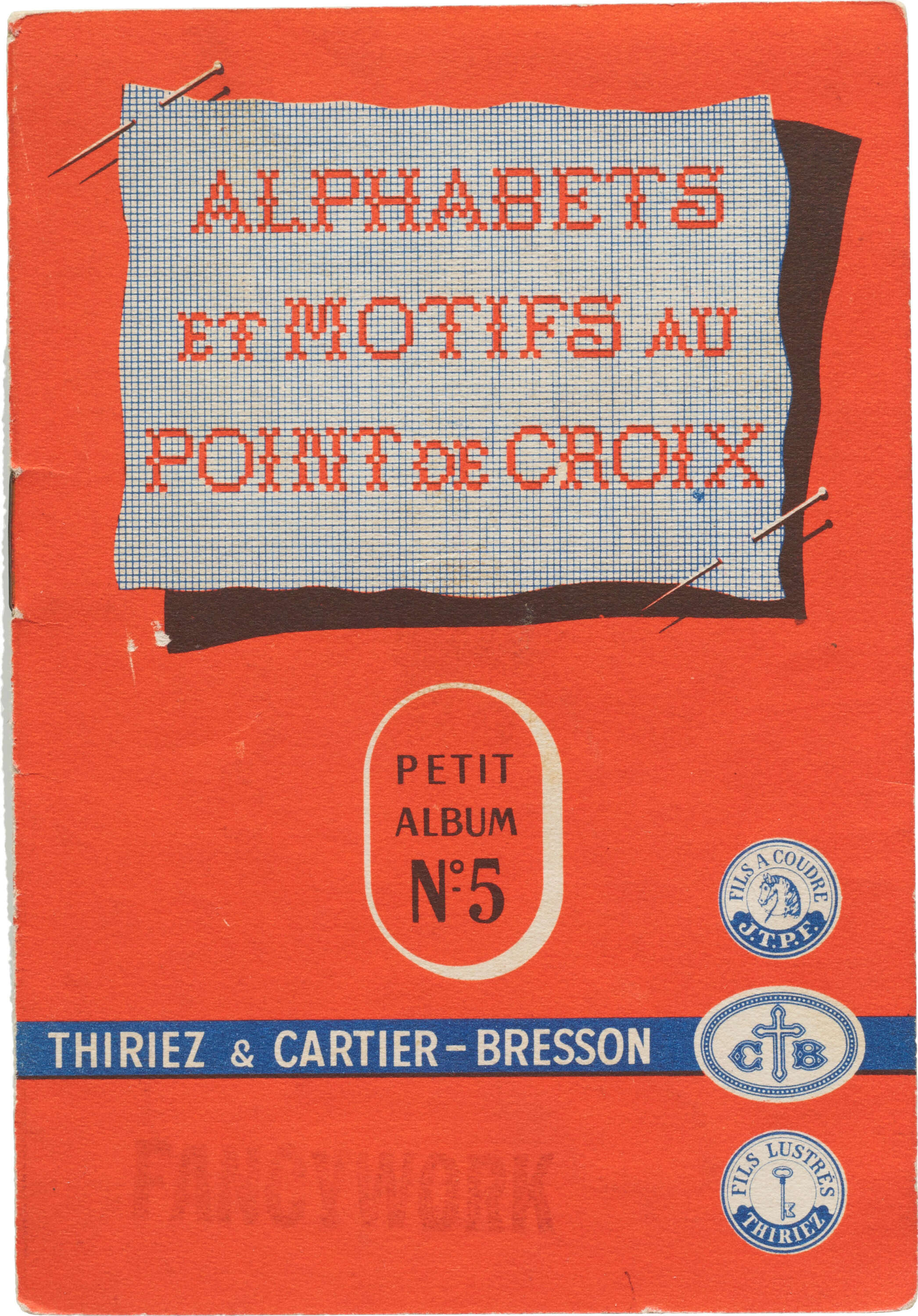
The Lille-based company Thiriez & Cartier-Bresson was a celebrated French textile manufacturer that specialized in producing high-quality threads used for sewing, embroidery, and crochet/knitting throughout the 19th and 20th centuries. As part of their promotional efforts, they crafted delightful pattern booklets, such as Alphabets and Motifs for Cross Stitch which remained popular well into the 20th century and featured an array of designs that evolved with changing styles and tastes over the decades. Along with a wide selection of lettering, image, and border examples, the book also includes a few design motifs inspired from East Asia. An elephant embellishes the bottom of a page, while a dancer labeled “Hindou Dancer” fills another.
Henri Cartier-Bresson, grandson of the company’s founder, was a well-known photographer who eventually gained global acclaim for his images of Gandhi's funeral in India. Cartier-Bresson had a connection with Southeast Asia and was married to Javanese dancer Ratna Mohini which might have influenced the designs in the Thiriez & Cartier-Bresson pattern booklets like the one shown here.
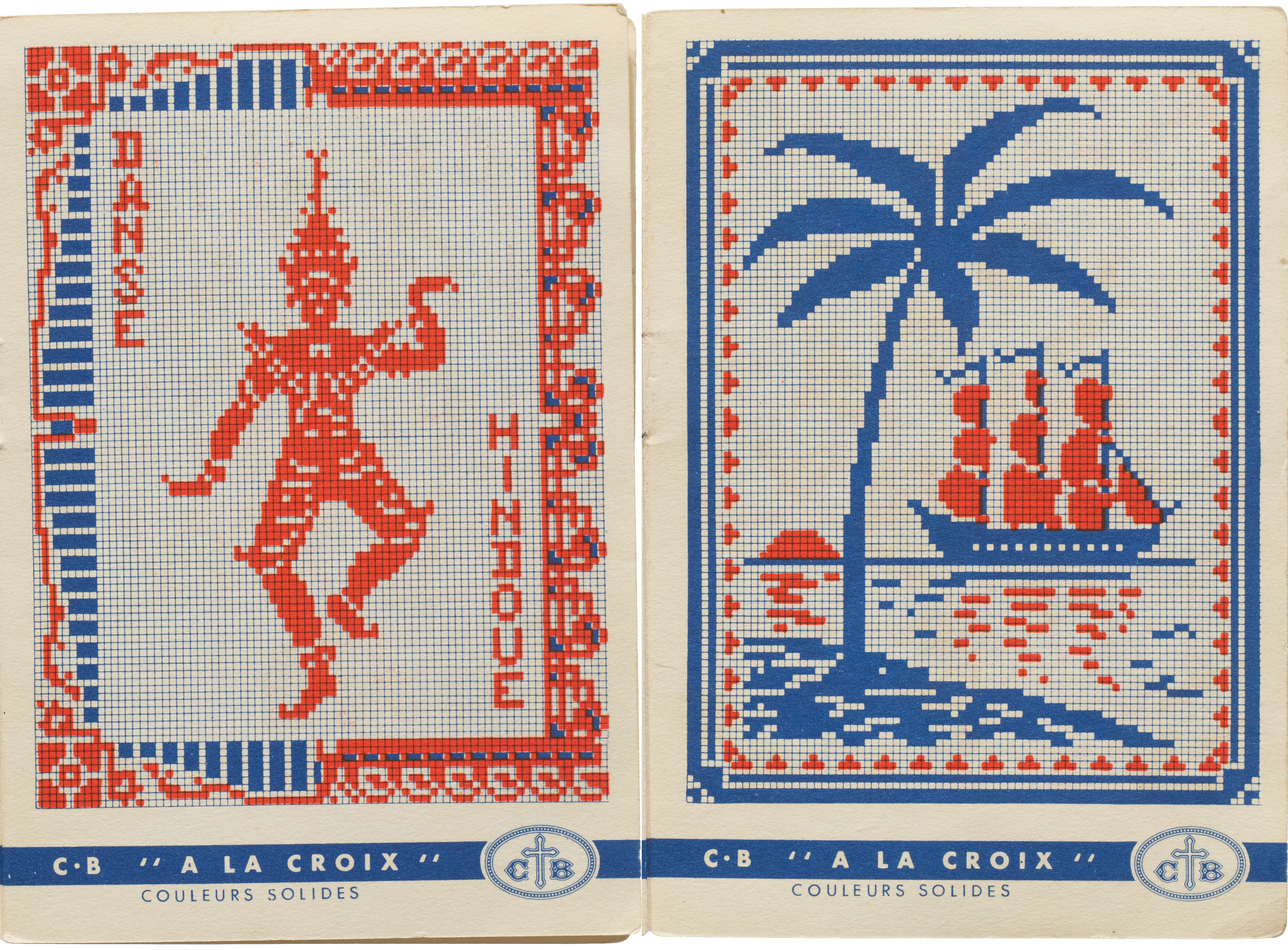
Alphabets for Embroidering on Canvas, No. 31
Publisher and location unknown, ca. 1890


This accordian book stretches to reveal an uppercase Latin alphabet in blackletter style adapted for stitching on canvas. Each page is decorated with a different border style, and a small set of numbers are also included. Embroidery on canvas eventually came to be known as needlepoint, where the stitches are counted and worked with a needle over the threads, or mesh, of a canvas foundation. The gridlines shown in the booklet would have helped with counting.
Needlepoint fabric is categorized by the number of holes per inch. When there are seven or eight to 16 squares per inch, it’s referred to as “gros point.” If there are fewer than seven mesh openings, it’s termed “quick point.” During the 16th to 18th centuries, needlepoint was primarily petit point, with 20 to 45 squares per linear inch, as seen in this booklet.
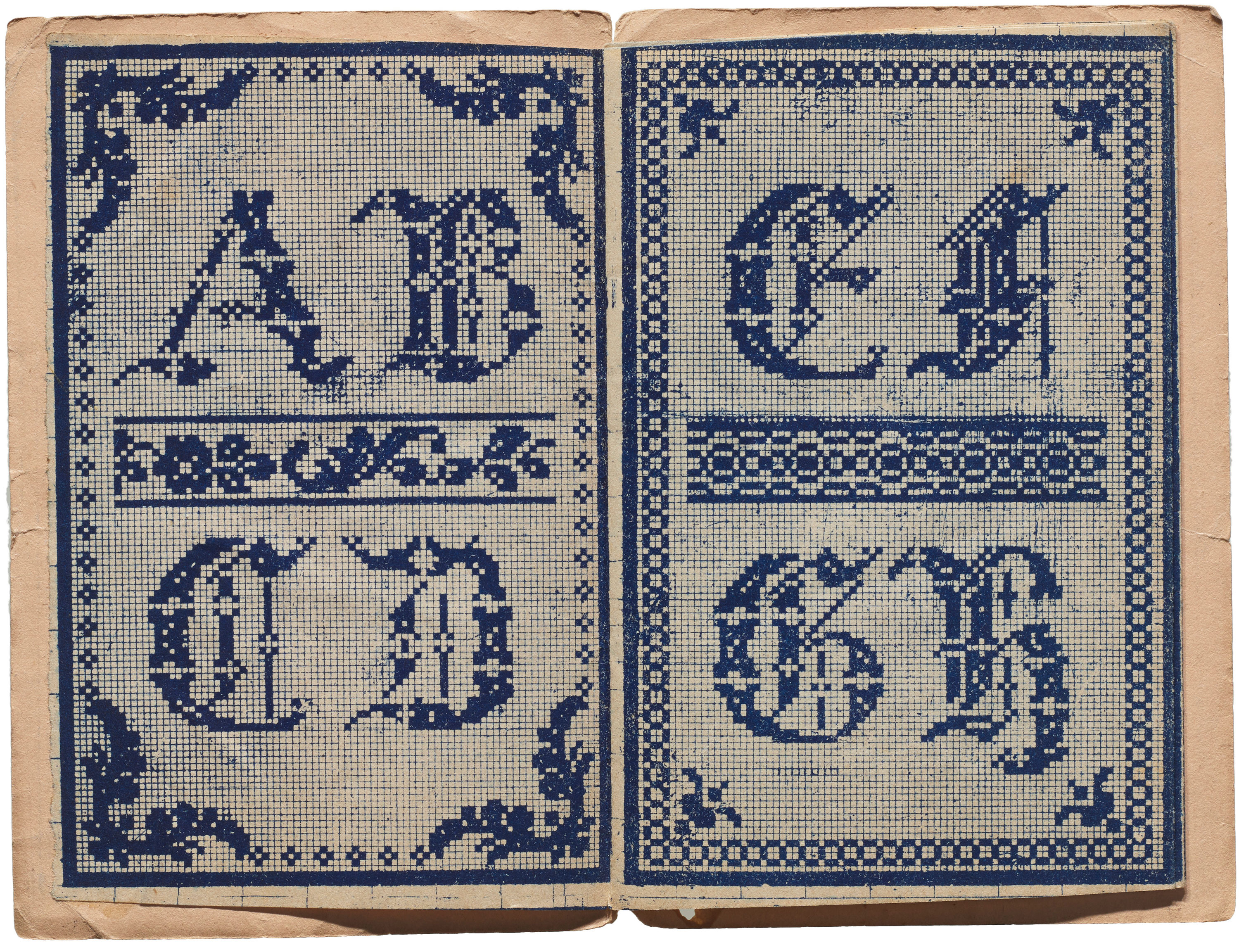
Anchor Transfer No. 940: Alphabets and Numerals
Coats Sewing Group, London, 1967
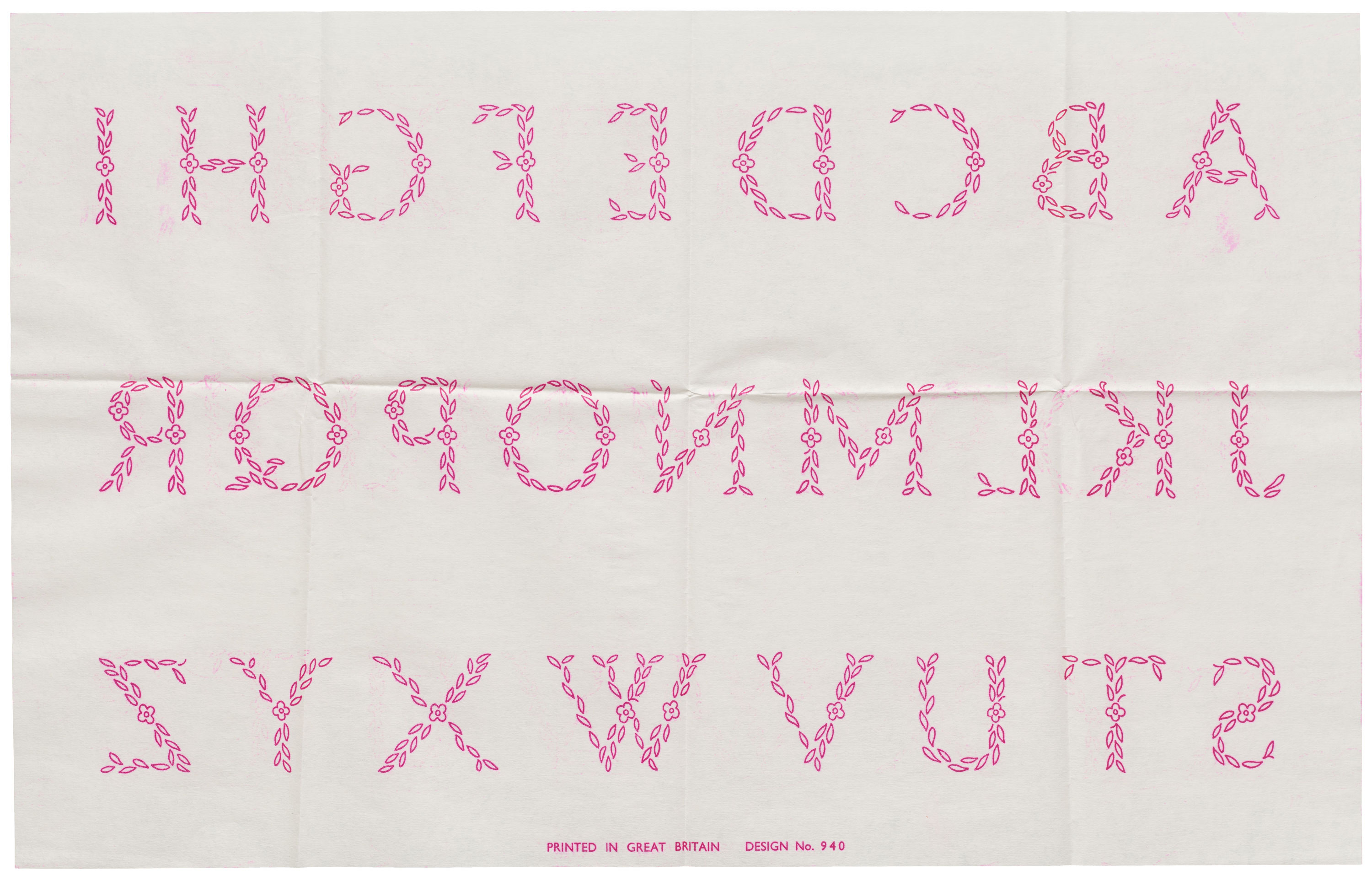
The Anchor brand’s history dates back to 1866 when the Clark family adopted the name for their embroidery threads manufactured in Paisley, Scotland. They eventually joined with the Coats Sewing company and emerged as the global hub for thread manufacturing. Mills and textile factories flourished from the late 18th century, ultimately dominating the town by the late Victorian era. This much-younger sewing guide comes with iron-on sheets for transferring designs onto fabric. The accompanying booklet offers additional lettering styles and instructions for transfer and embroidering.
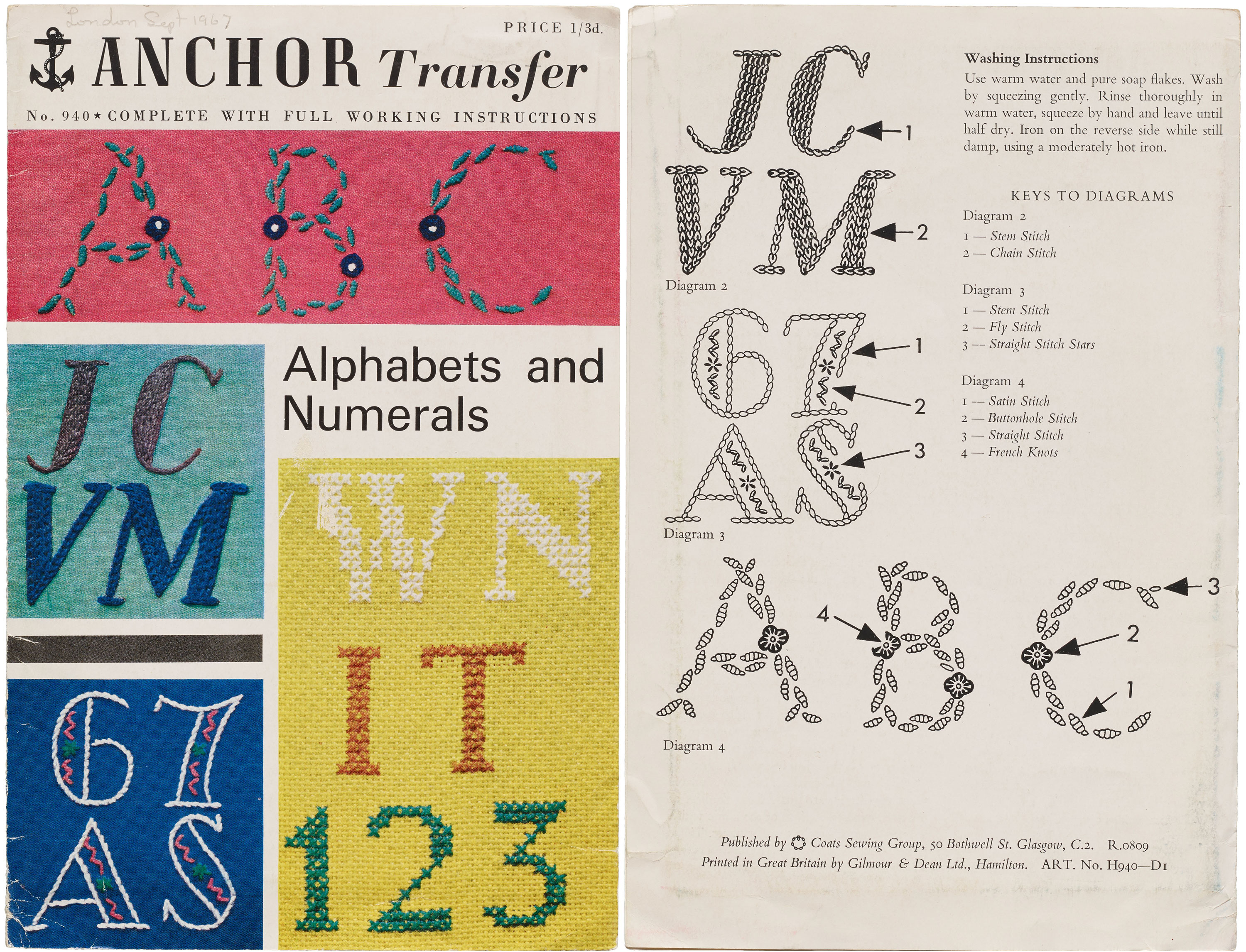
One Hundred Thirty Antique French Embroidery Alphabets
J.F. & F.A. Shepard, BookSurge Publishing, Charleston, SC, 2008
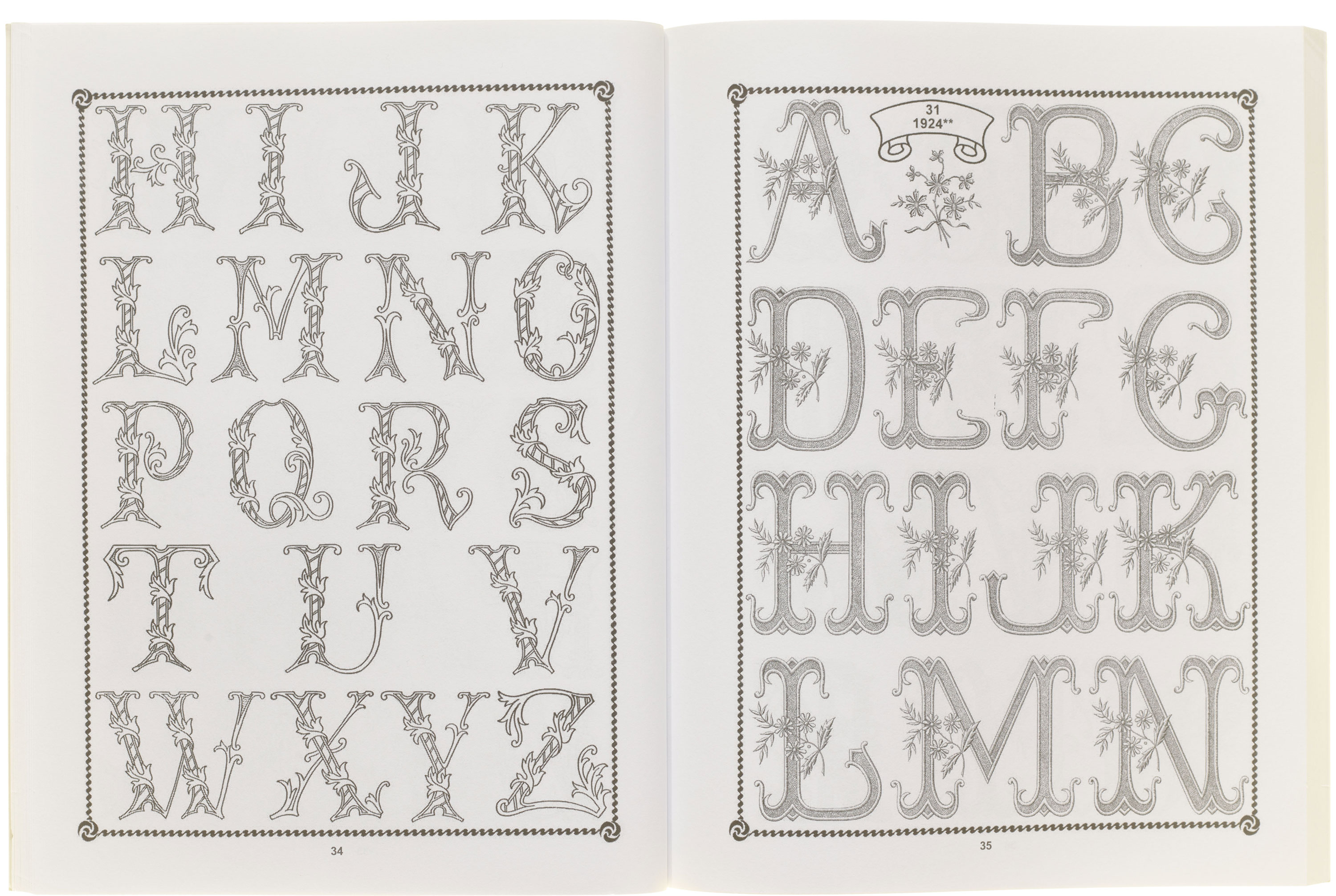

This handy addition to any embroidery library features a compilation of 130 alphabets sourced from French publications dating as far back as 1864. The styles encompass a wide spectrum, ranging from simple and decorative block to fancy script, gothic, oriental, cutwork, bracketed, petite, and more. Each set of letters presents elegant application concepts and exudes a distinctive flair seldom found in contemporary styles. Some of the included alphabets have only 24 or 25 letters instead of the modern 26 as letters like I, Q, and sometimes W, were frequently replaced by a J, O, or an inverted M.
Dessins de Broderies: Märkbok Alphabet
Publisher unknown, Germany, ca. 1900

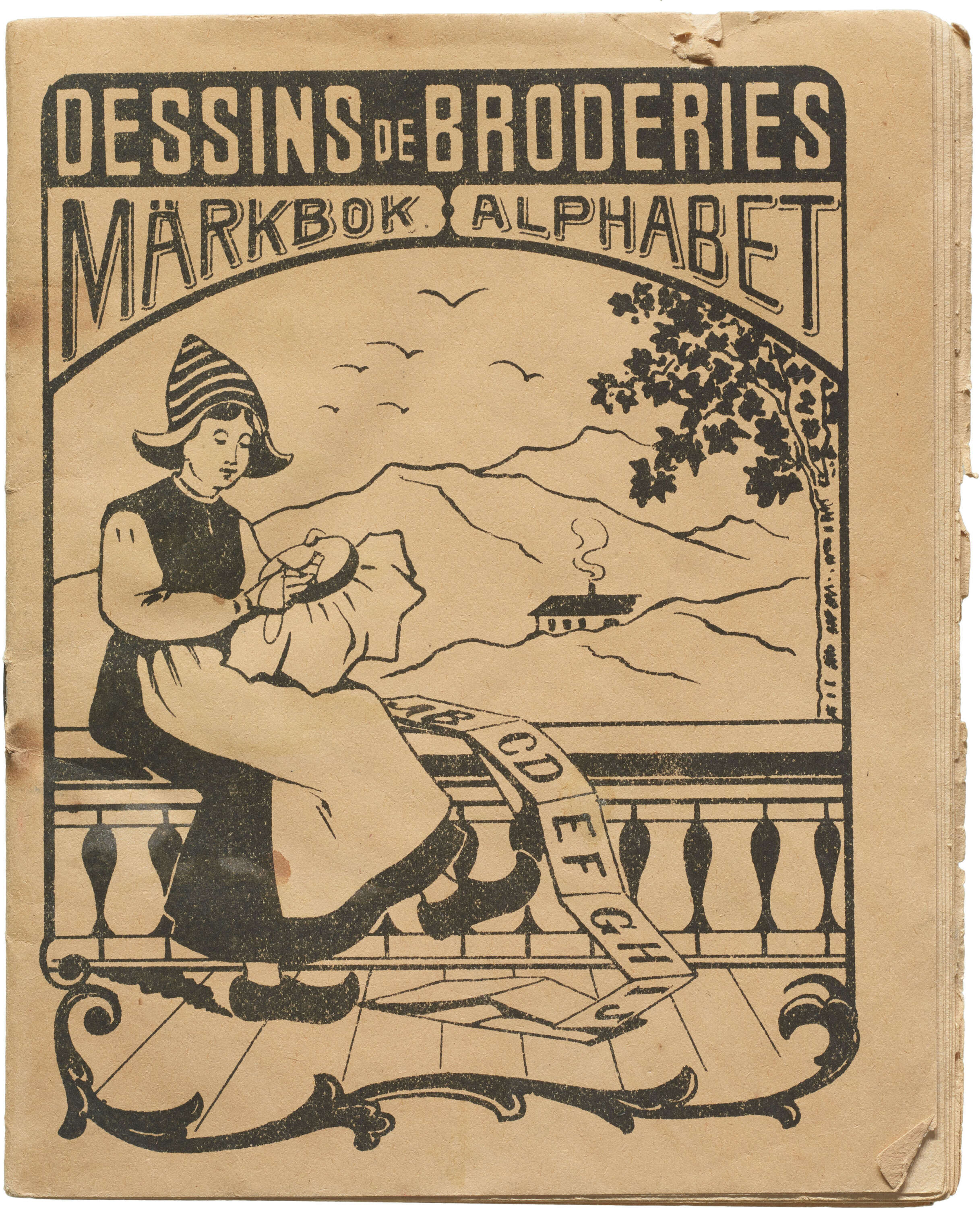
Design for Embroidering: Alphabet Marking Book is a simple German exemplar with various alphabets in blackletter styles, script initials, and letters with decorative interwoven elements.
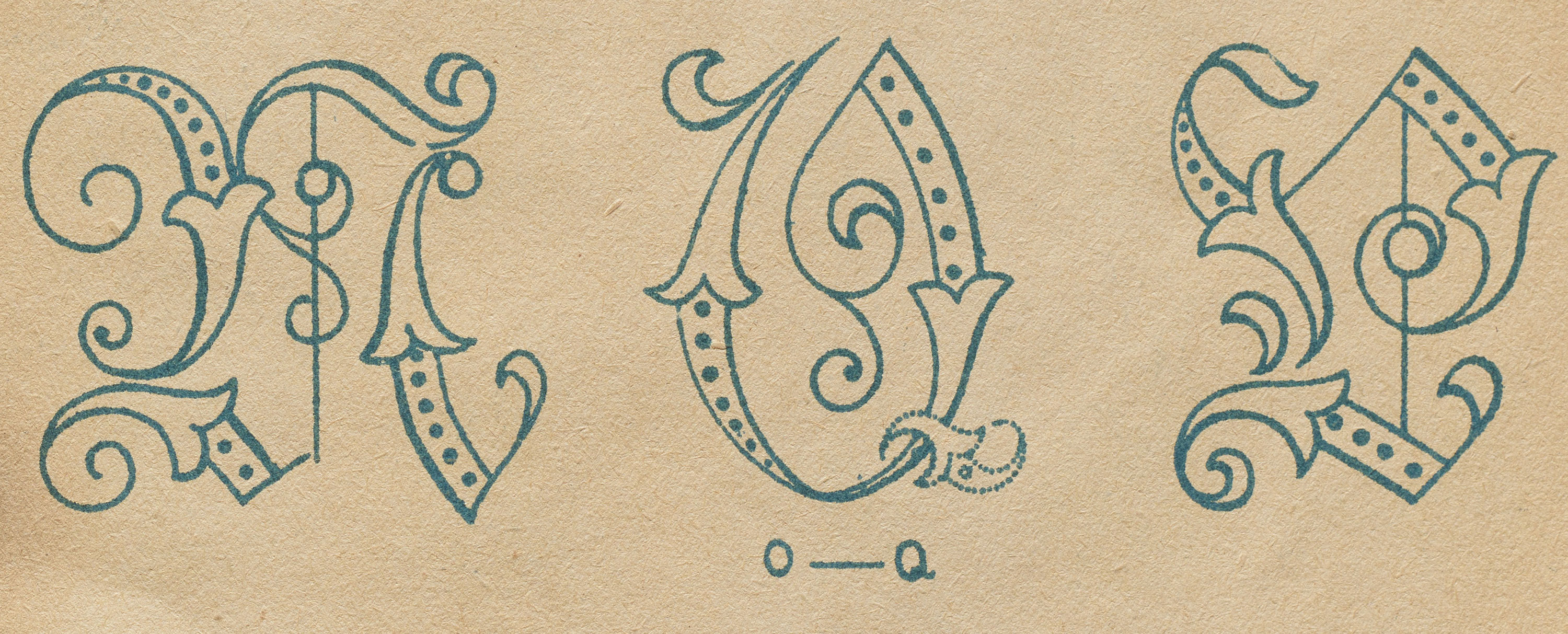
A Handbook of Lettering for Stitchers
ICA Förlaget, Västeras, Sweden, 1966

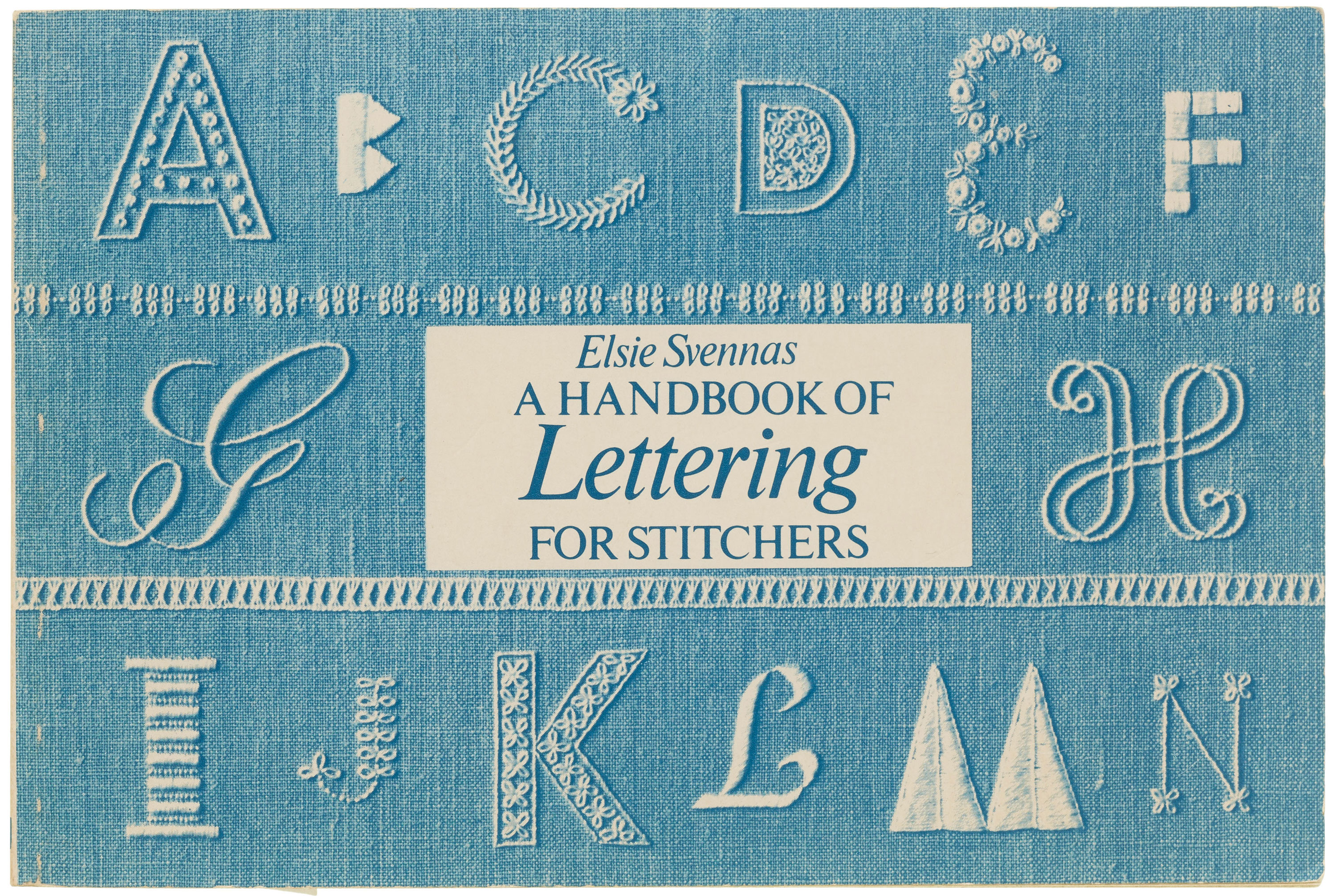
Elsie Svennas employed a creative blend of stitches to embroider the letters on the book’s front and back covers. The inside is filled with various styles of letters that can be accomplished with a host of different embroidery techniques. Peppered through her book are captivating monograms and demonstrations of combining letters with decorative elements. The book also includes a concise history of fabric marking and monogramming, discussions on material options, and pages filled with charted and illustrated designs for letters.
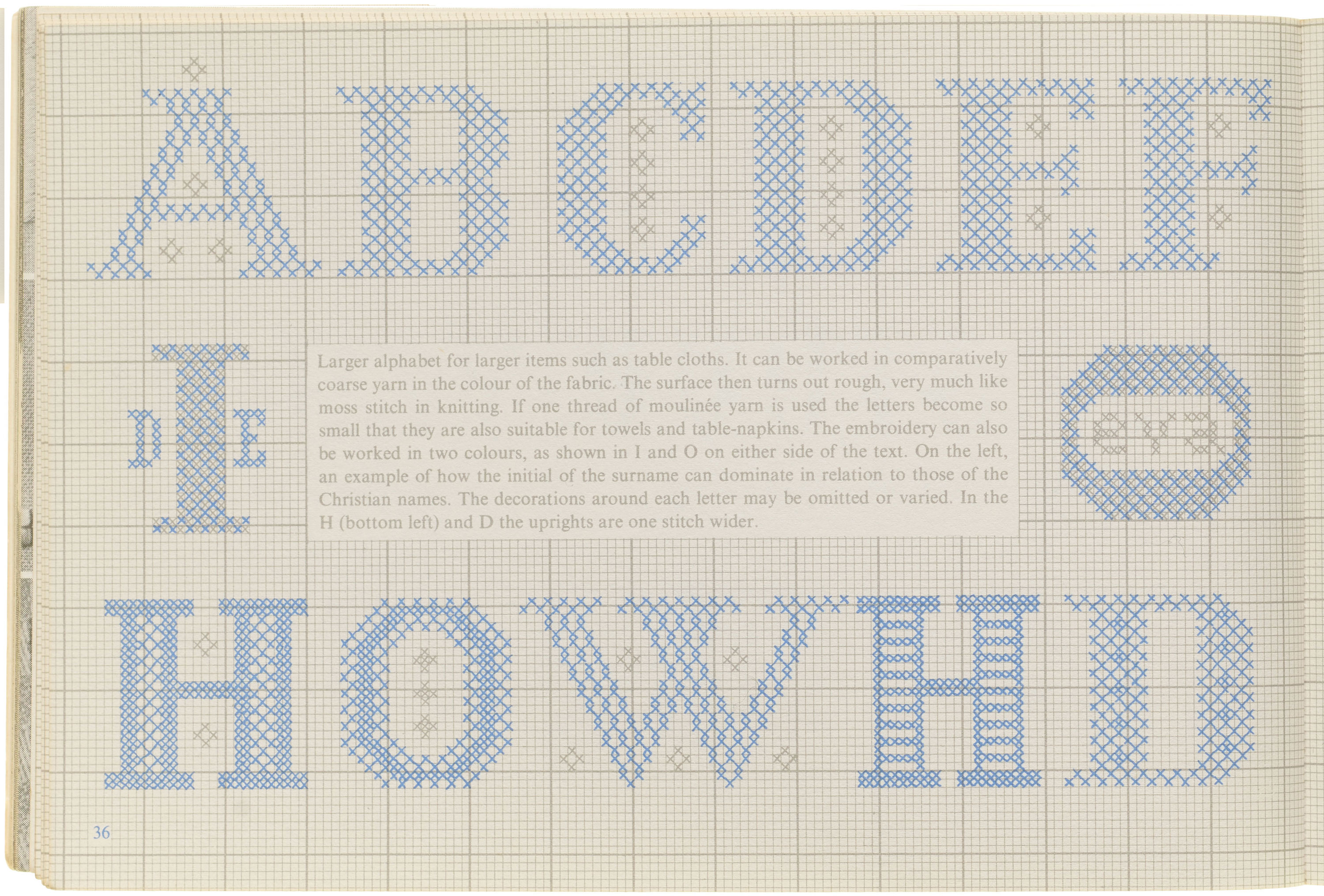
Ladies’ Hand Book of Needle Work
Centemeri Kid Glove Co., Boston, 1879
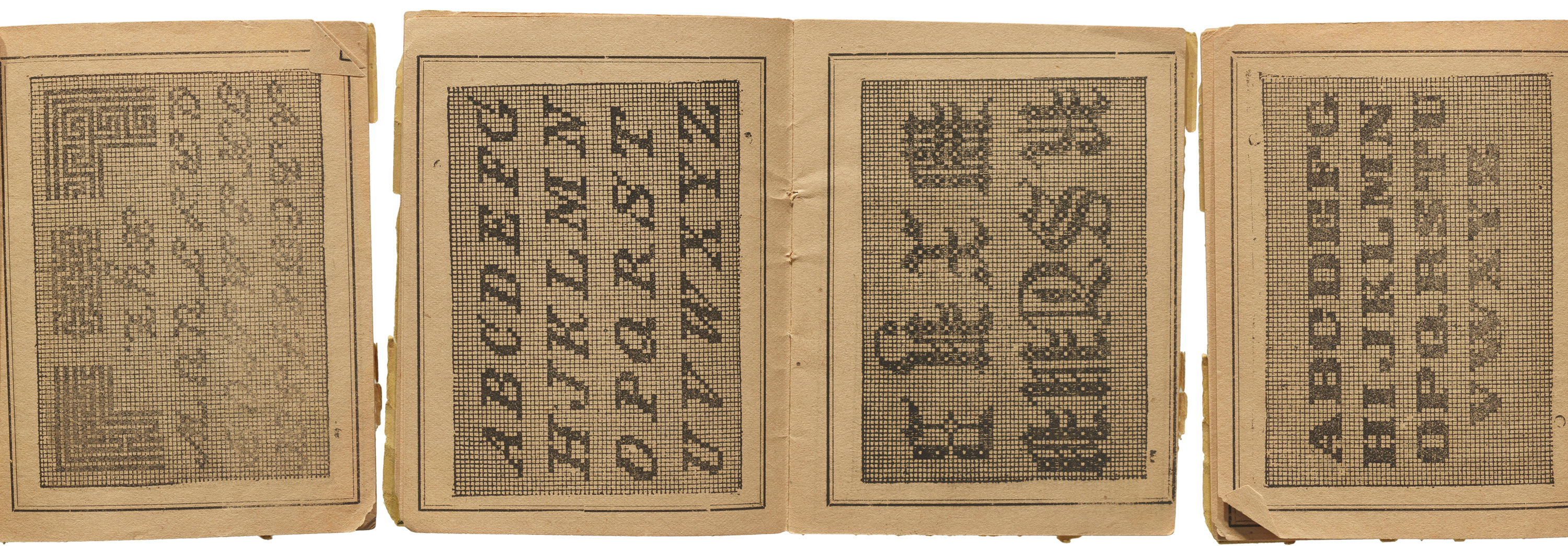
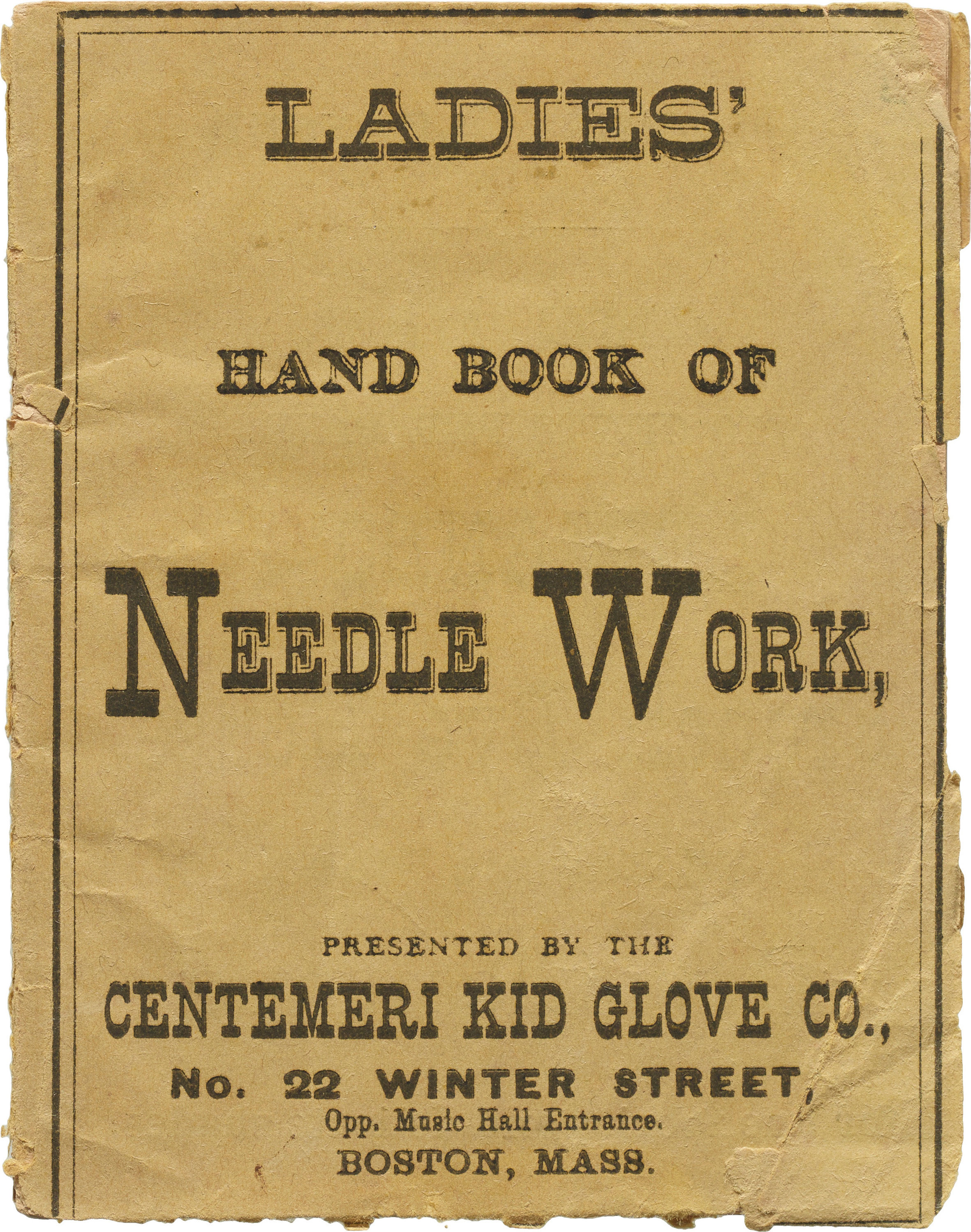
Centemeri Kid Glove Co., a manufacturer based in Boston, published this pocket-sized booklet as a promotional device. The embroidery alphabets lay on a grid that allows readers to count the stitches and practice needlepoint. The book also contains other floral motifs and border and corner patterns bookended by advertisements for a glove dry cleaning service and a perfumery.

(Letterlap) gestickte Schrift ; zwanzig Stichpunkte zur Geschichte einer textilen Schreibtechnik
Inst. für Buchkunst, Leipzig, 2009
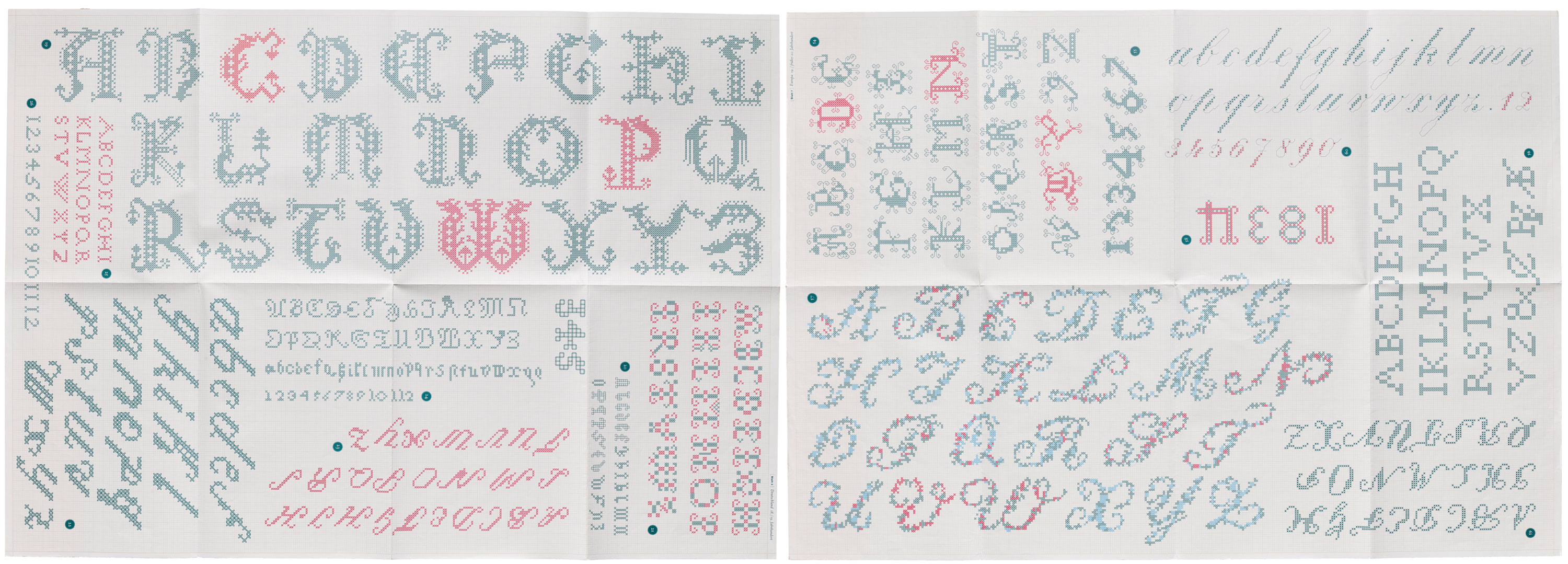
Letterlap is a contemporary reference that collects vintage alphabet samples and sheds light on the history of embroidery. The first part, titled “Embroidery Fonts: A Sample Collection,” presents 60 lettering samples across seven leaflets. These examples were compiled and digitized by Janine Thaler as part of her diploma thesis in 2006 at Leipzig University of Graphics and Book Arts. A plethora of styles across various scales are beautifully captured in a tetris-like arrangement, and the details are beautifully reproduced.
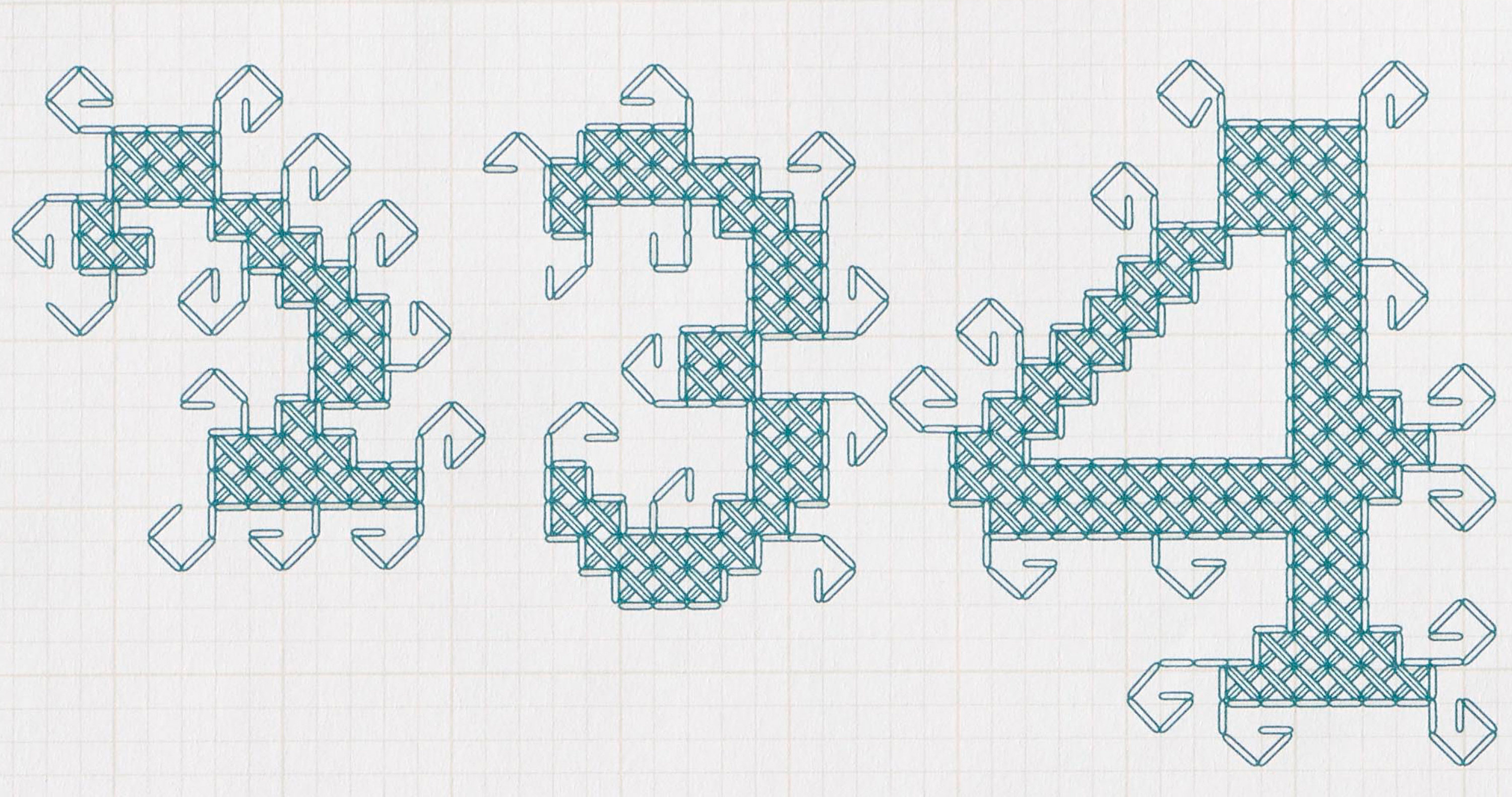
The leaflets are accompanied by Embroidered Writing: Twenty Bullet Points on the History of a Textile Writing Technique. In this 64-page booklet, author Jan Wenzel explores various aspects of the cultural history of embroidery in general, with a focus on the letters created with it.
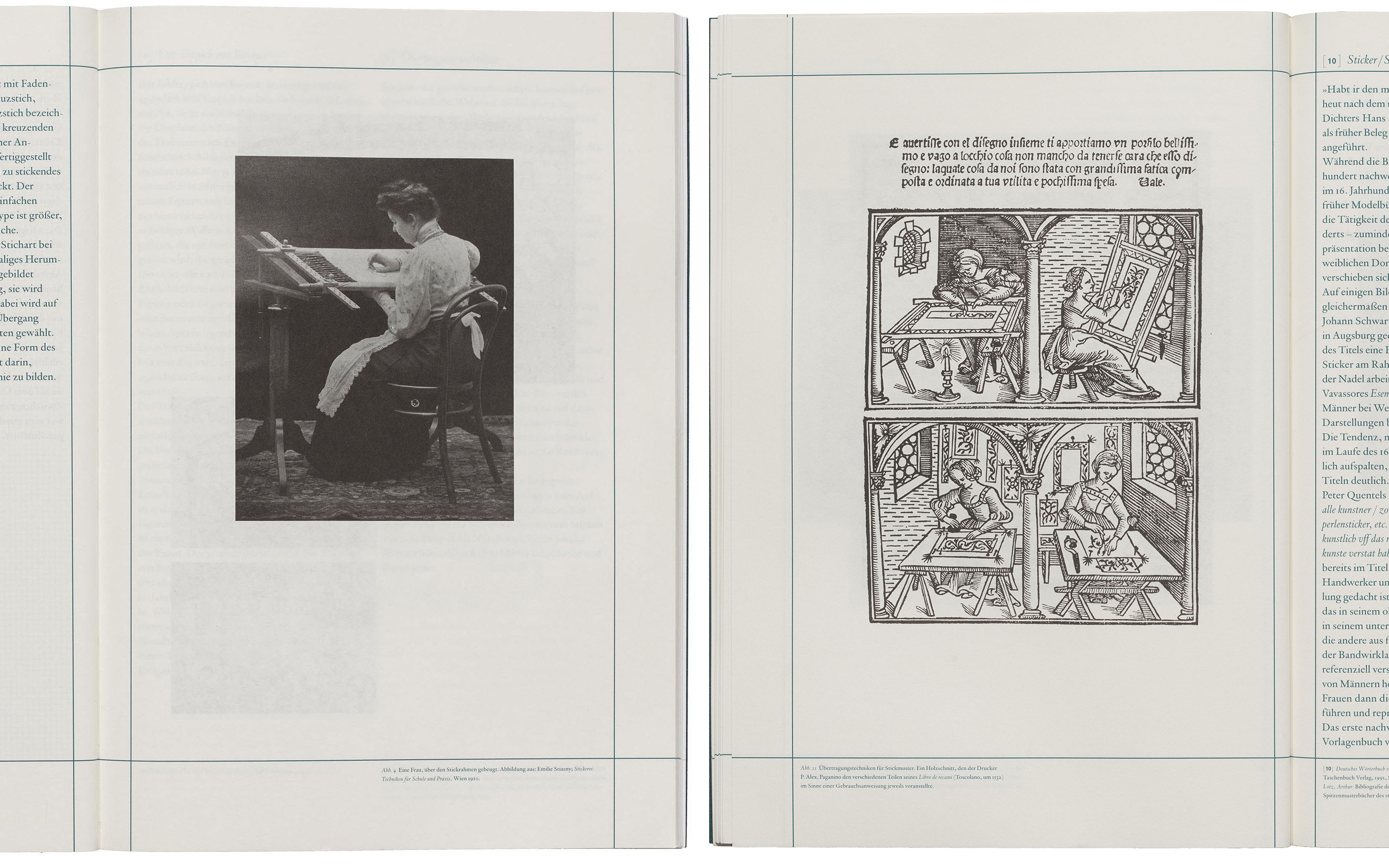
Märkbok: Urgiven av Augusta Abrahamsson
Melins/Esselte, Göteborg, Sweden, 1966
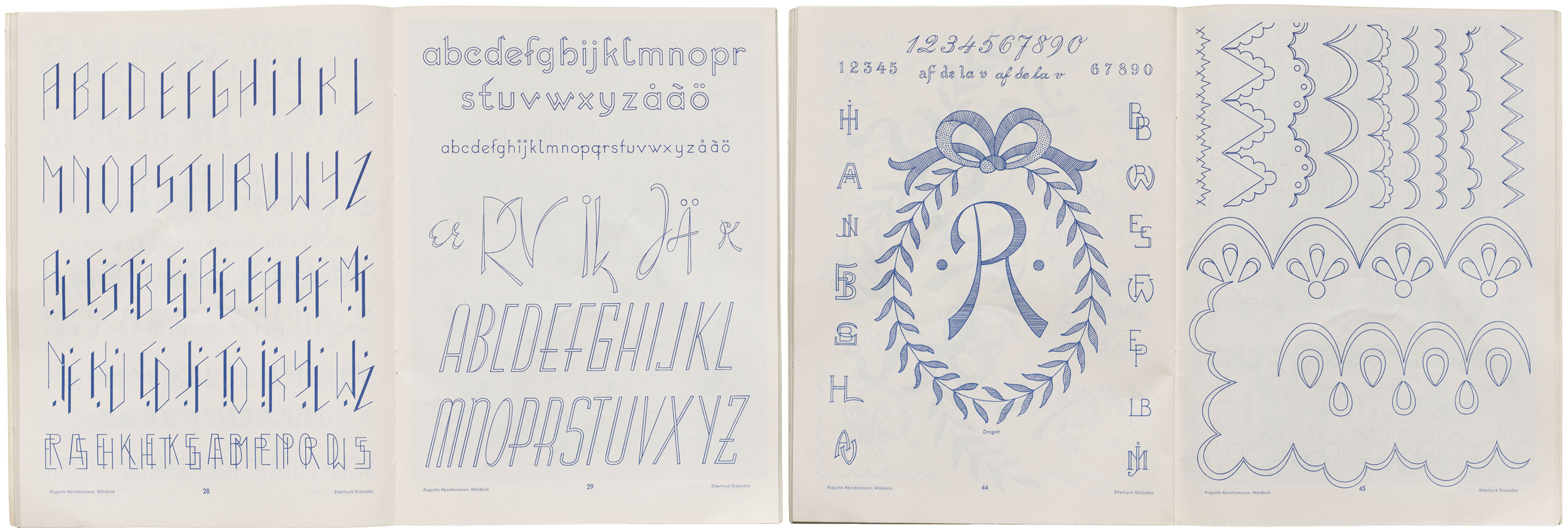

The cover of Märkbok recognizes Augusta Abrahamsson, a Swedish woman born in Skaraborg in 1858. She resided there until the age of 33 before relocating to Stockholm, where she began her career as an embroiderer at a renowned Swedish department store. In 1909, she published Märkbok for the first time with Linköpings Lithografiska AB. From 1909 to 1976, the publication underwent over 42 editions, totaling more than half-a-million copies. Consequently, it became a household essential in virtually every Swedish home for generations.
The edition at the Archive is likely a more recent edition published by Esselte, a Swedish stationery brand. It includes designs that would lend themselves well to cross stitch and needlepoint as well as simplified sans-serif designs that intersect to form interesting monograms. Abrahamsson passed away in 1950, nearly 92 years old.

Typographic Knitting: From Pixel to Pattern
Princeton Architectural Press, Hudson, NY, 2020 (English ed.)
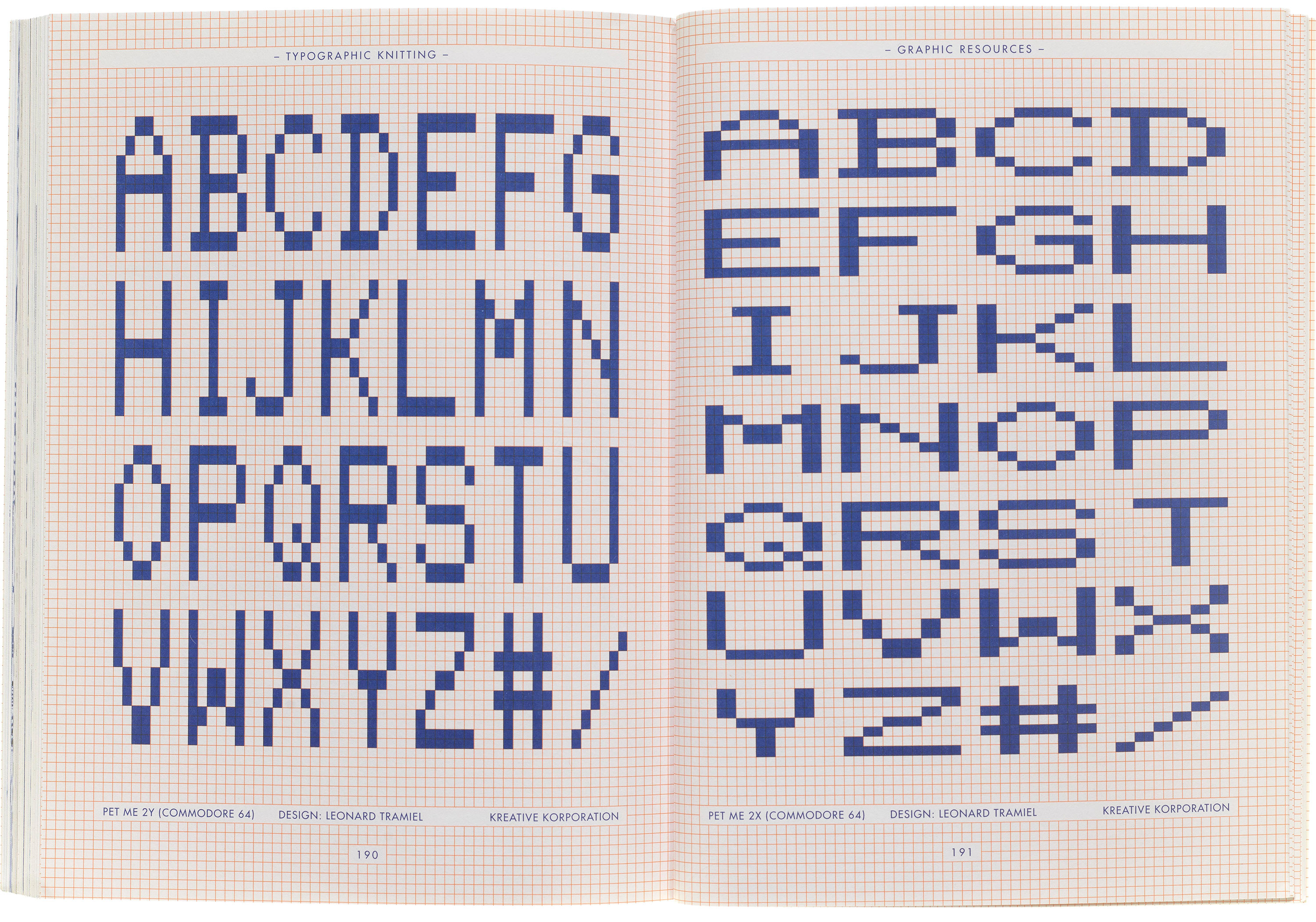
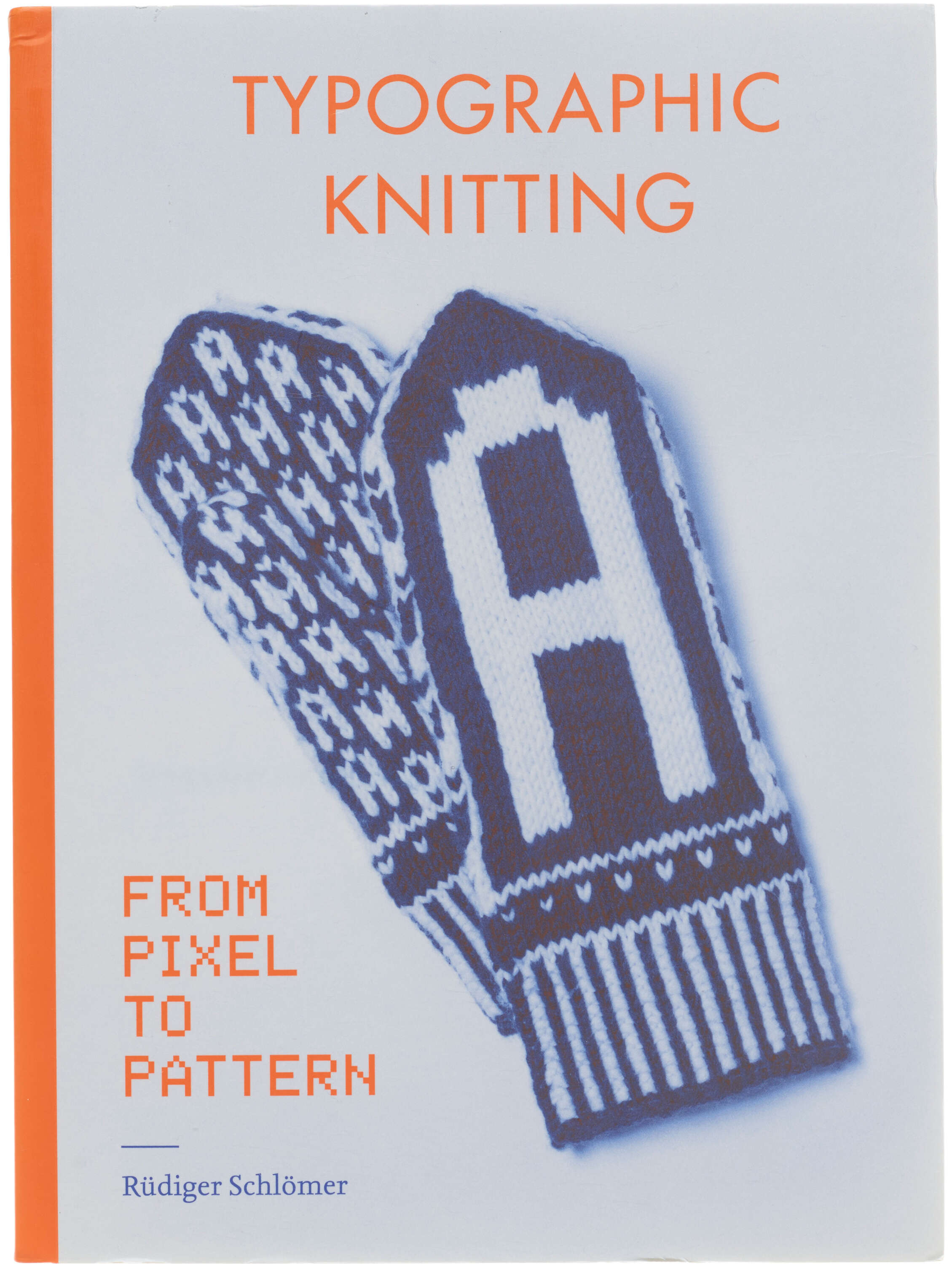
Rüdiger Schlömer’s book introduces various methods for integrating typography into knitting practices. The main content provides deep instruction into crafting alphabets through knitting techniques and offers a variety of additional projects like pullovers, scarves, mittens, and hats, each illustrating unique applications of typographic knitting. These projects exhibit a variety of patterns adapted from other designers, alongside original designs.
The book also presents an unusually valuable resource: 32 knittable typefaces obtained from various type foundries. Schlömer designed his own family, Knit Grotesque, which is a low-res adaptation of Futura translated into a hand knittable pattern. He conducted a Writing with Wool workshop at the Archive last year.
Cours de Théorie pour le Tissage
J. Richard (student) and P. Audibert (teacher), Lyon, 1882
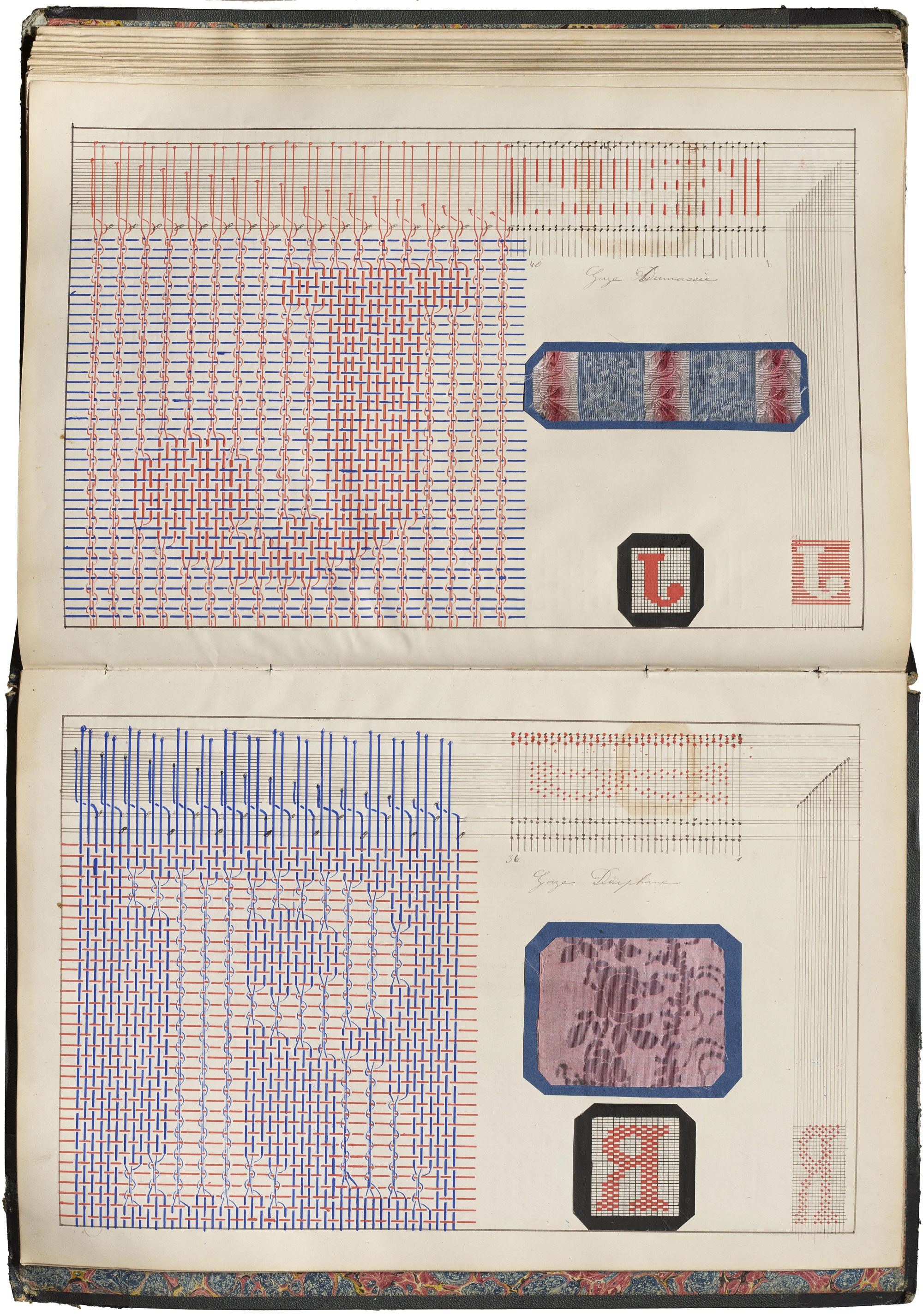
Created in 1882, Weaving Theory Course is a manuscript with hundreds of intricate hand-drawn diagrams that show in-depth instructions for Jacquard loom weaving. The book appears to be an elaborate student project produced by J. Richard in a course taught by P. Audibert. (Similar manuscripts by other Audibert pupils can be found in other collections, such as the Art Institute of Chicago.) It opens with a portrait of Joseph Marie Jacquard who first demonstrated his invention in 1804: a revolutionary loom that enabled unskilled workers to weave intricate patterns in silk. The Jacquard loom operates through a series of punched cards, controlling which cords of the fabric warp are raised with each shuttle pass. This innovative system enabled the storage and automatic reproduction of complex operations, revolutionizing textile manufacturing processes and enabling pattern changes by swapping cards. The technology is widely regarded as an early precursor to computer programming and data entry.
Along with the meticulous instructions and drawings, the book also includes tipped-in fabric samples and a set of cardboard punch cards. As a delightful addition, the title page and subsequent section separators are hand-lettered in peculiar chamfered styles of the period.
This recently arrived masterpiece deserves more research, and really needs to be seen in person. Meanwhile, we offer this abbreviated pagethrough video:
Embroidered Objects at the Archive
Sophie Calle: Rachel, Monique…

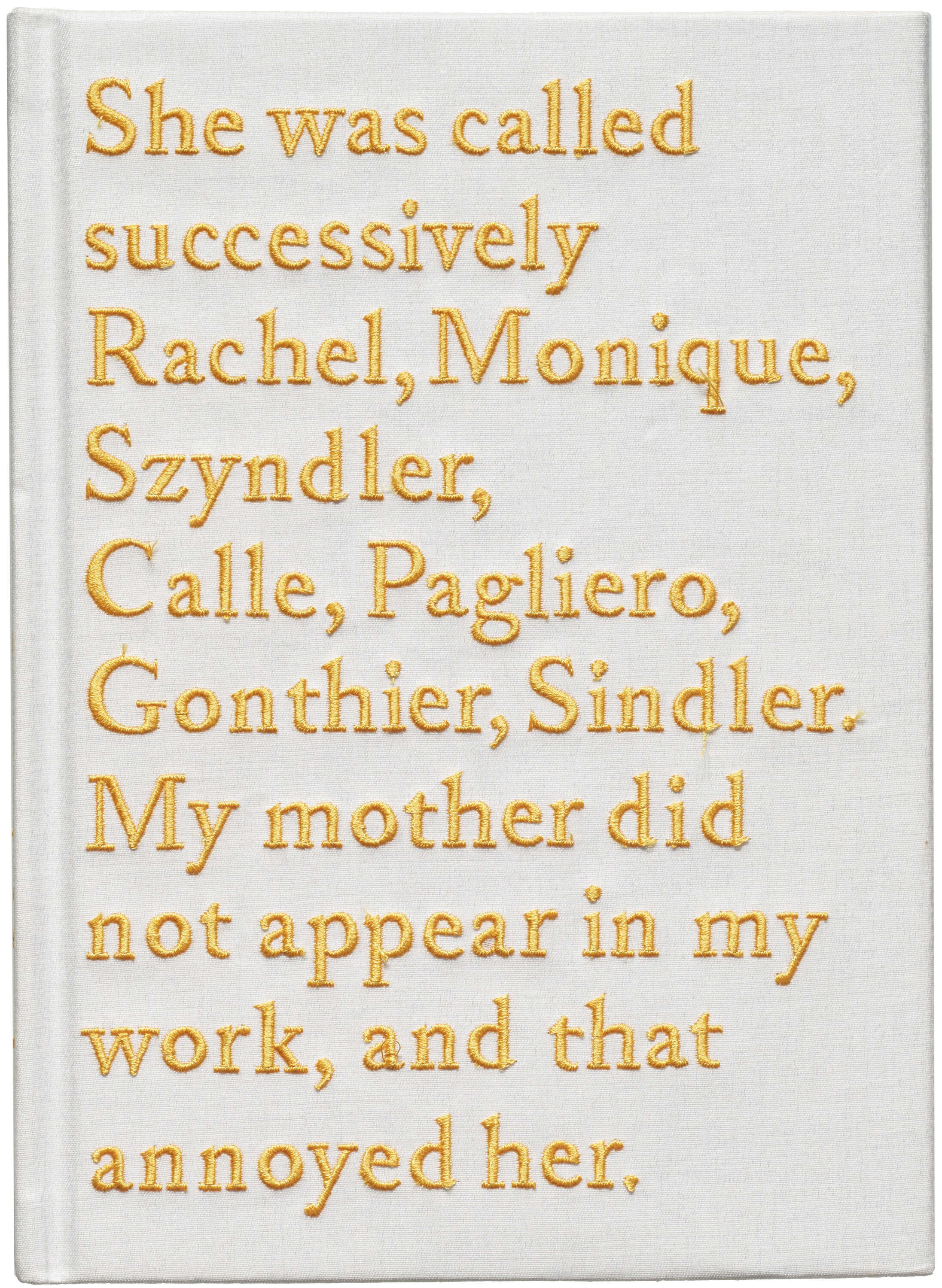
Narrating the life of Monique Szyndler, mother of artist Sophie Calle, who passed away in 2007 this poignant narrative unfolds through diary entries and carefully chosen photographs from family albums, curated by the artist herself. Embroidered on the cover are the opening lines: “She was called successively Rachel, Monique, Szyndler, Calle, Pagliero, Gonthier, Sindler."
This volume, showcasing Calle’s installations at the Palais de Tokyo, was meticulously crafted by Xavier Barral and Émilie Regaud in close partnership with the artist. The cover text is rendered in delicate embroidery, making it a cherished artifact, while all texts relevant to the installation are elegantly embossed within.
Mourn and Uncertainty
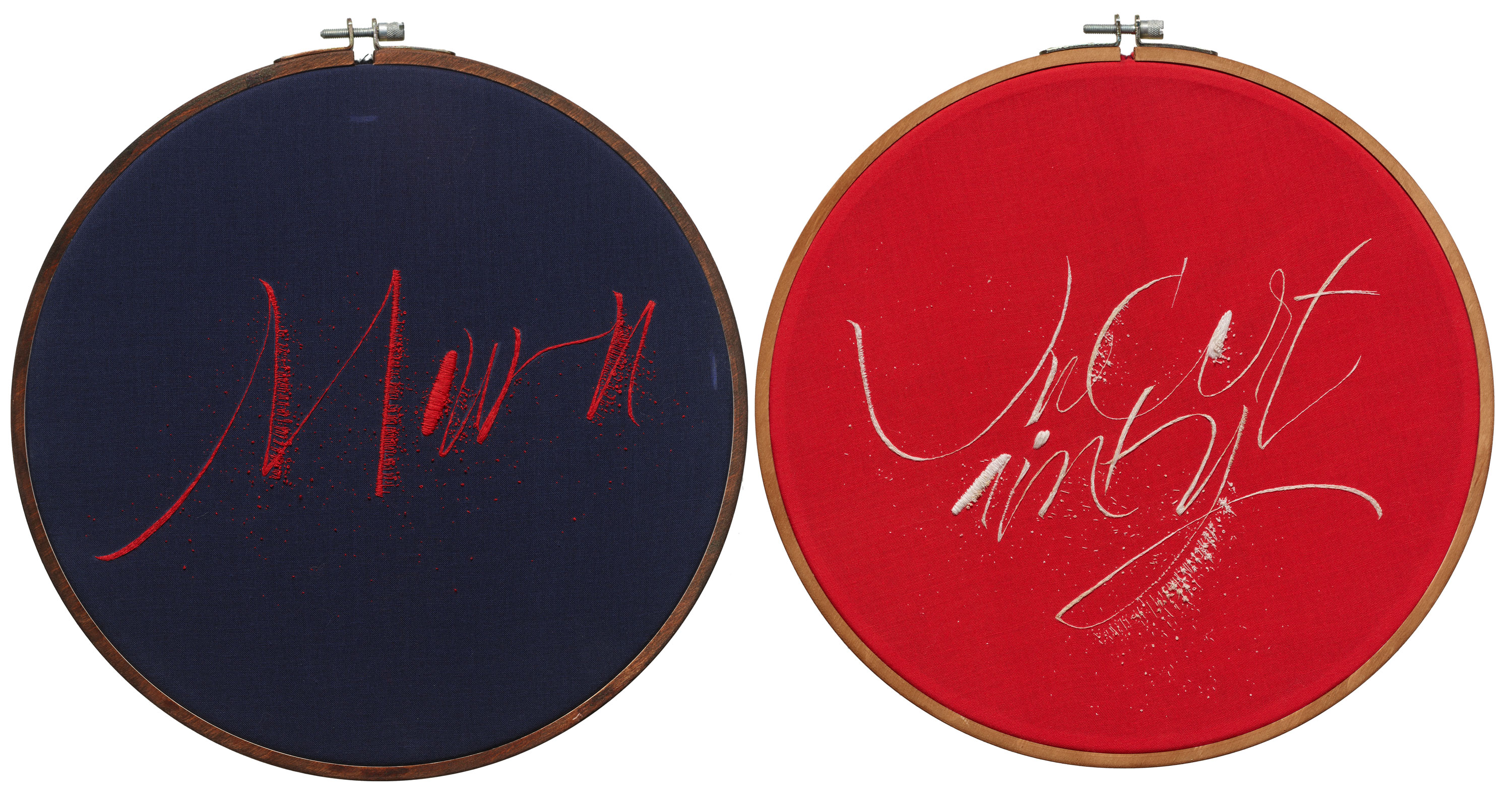
In this pair of artworks generously donated to the Archive, Olga Kovalenko uses embroidery to explore the emotional impact of calligraphy. She enjoyed the paradox of rapid calligraphy combined with the deliberate and tactile nature of embroidery. The words selected to embroider reflect enduring sentiments, aiming to hasten or prolong their impact. Kovelenko meticulously captures the sometimes incidental marks that a pen makes, committing them to cloth with a needle.
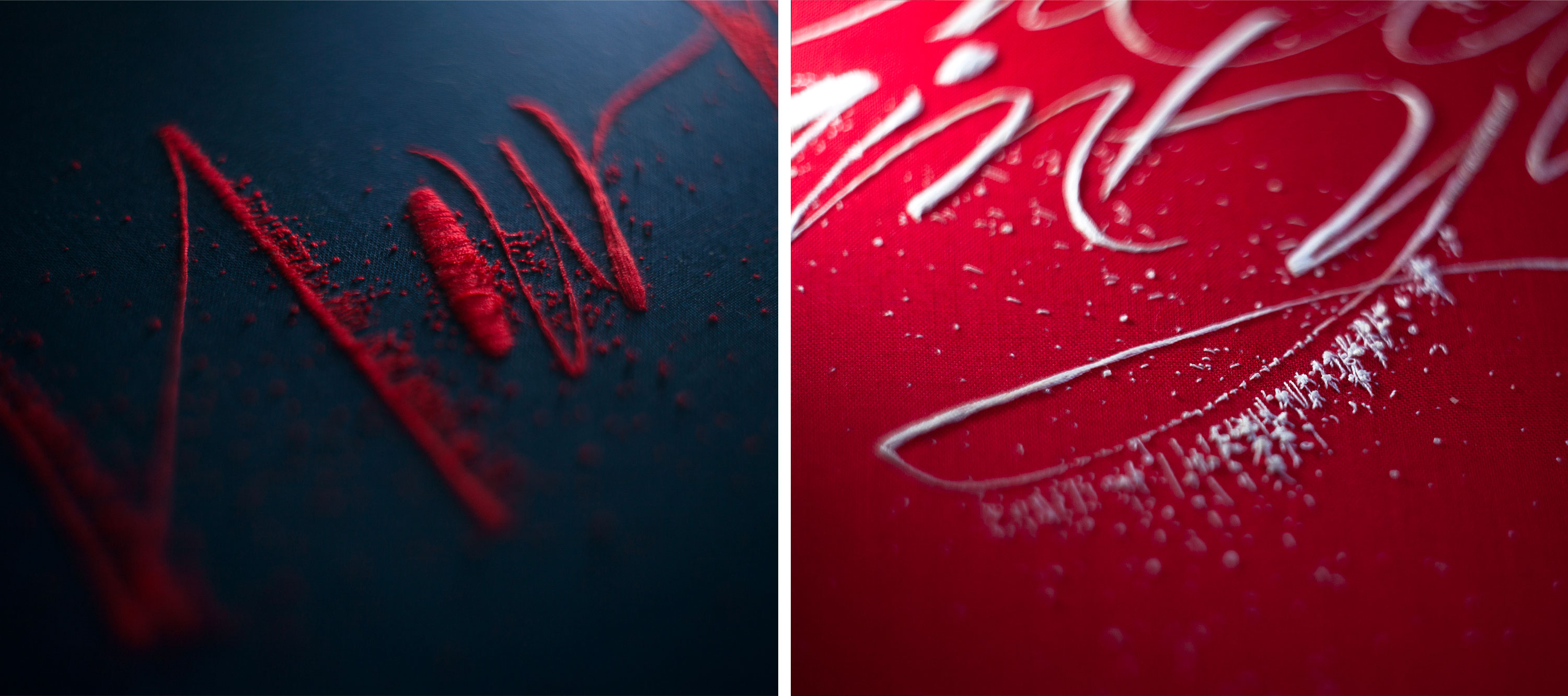
دُعا (Prayer)
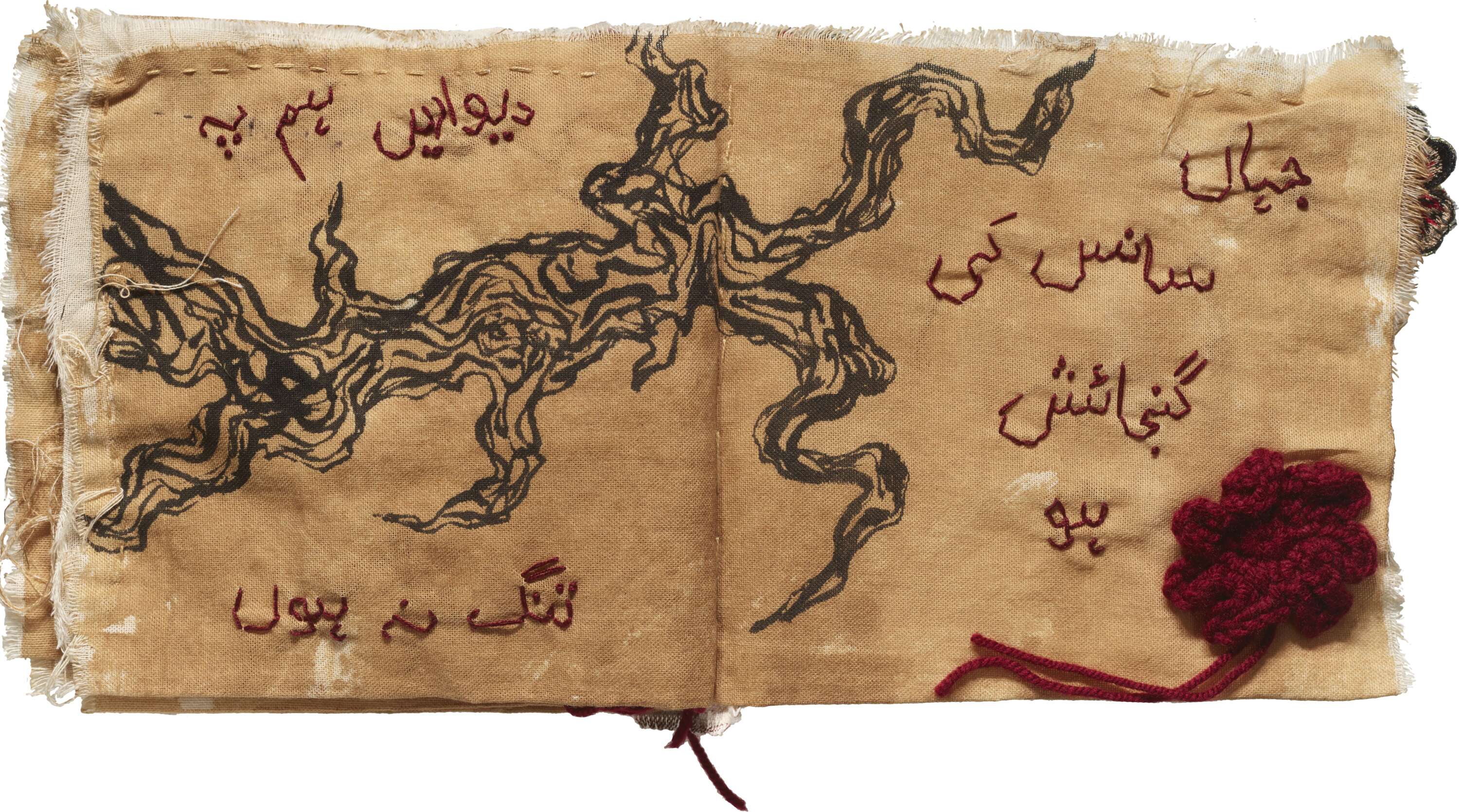
Halah Khan used mixed media elements such as embroidery, ink, pearl, cotton thread and wool to construct this artist book titled دُعا (“Dua”, meaning prayer). The tea-washed book features embroidered and crocheted flowers, with the cover having a central hand crocheted “taweez” (talisman), surrounded with golden zarri thread embroidery and a floral header piece. This book is a part of a series by the Pakistani artist, which embodies various conceptions of home: haqeeqat (the reality of it), khuwahish (the home one desires), or a dua (prayer, in this case for the possibility of a home). The text embroidered inside wishes for the possibility of a home where it is easier to breathe.
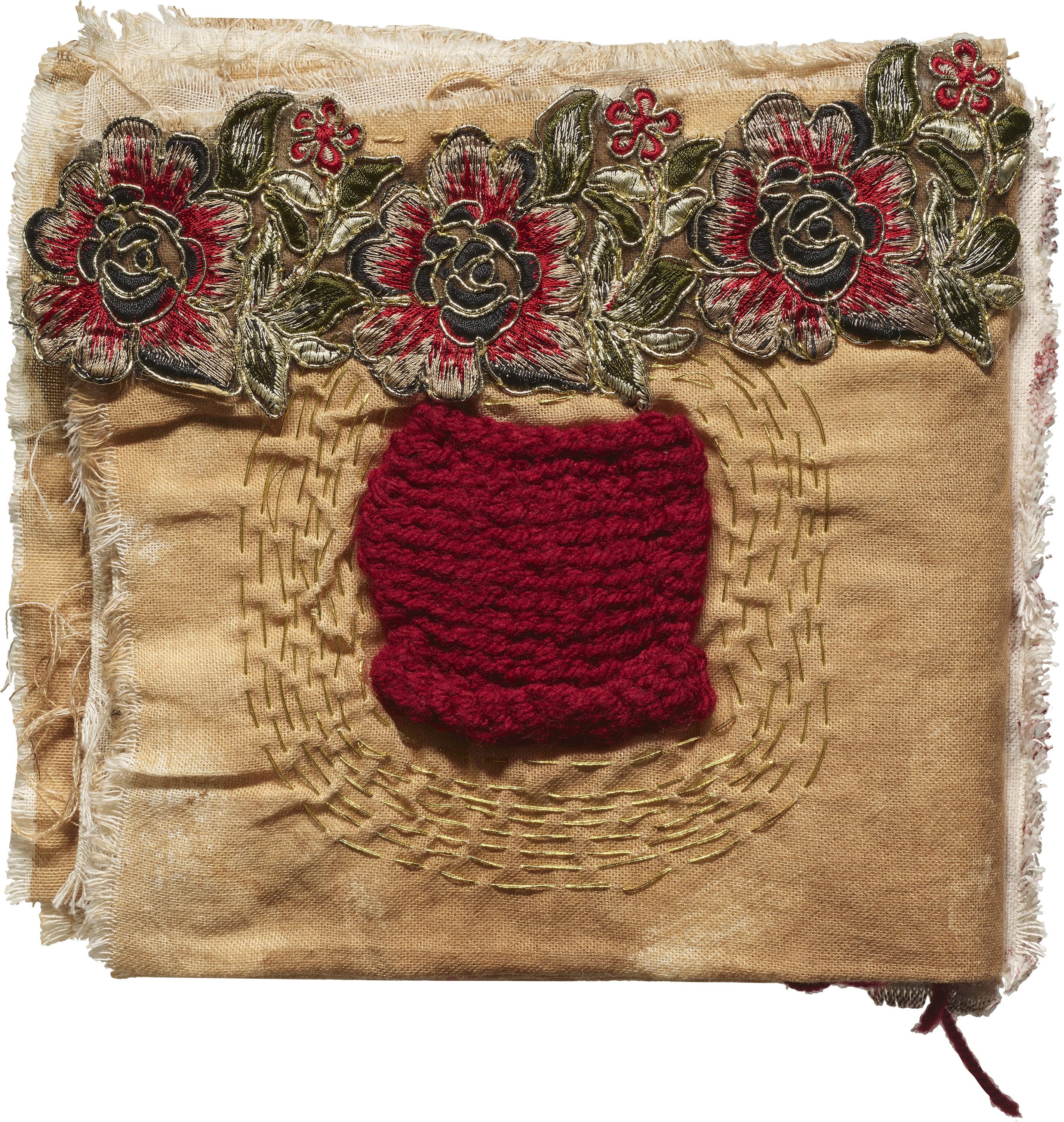
The Archive's reference library is as captivating as its archival collection. In our ongoing “For Your Reference” series, we'll delve deeper into the vast and varied stacks. While I examine these books from a distance, the Archive warmly invites research visitors to explore them in person. Delve into the library's comprehensive resources and let them inspire your own creative endeavors.
— Tanya George
